2014年02月27日
Sakaide Revival
Looking for something unique to do on your next day off or somewhere cool to take your friends or family? Check out The Art Project for the Abandoned Fujita Hospital in Sakaide City, just a short train ride from Takamatsu JR station. Sakaide, once a bustling port and salt producer, has seen its thriving shopping district slowly decay.
But the city still has many unique buildings and some very enterprising and interesting people. When the roof was removed from one part of the shopping arcade recently, it brought an abandoned hospital into view.
Fujita Hospital
Determined to breathe a little life back into the district, a project team was formed. Their idea? Invite artists to adopt a room within the hospital as their creative space.
The project, which started on January 8, will continue until May 5. The artists and exhibits change every month and they range from weird to wonderful. Here are a few scenes to give you an idea (but please note the exhibits have already changed so look forward to something new!).
Aloe in Japanese is known as “ishinashi” or “no doctor”, and the artist, who moonlights as a gardener, used the abandoned operating room to play with this theme.
The pharmacy featured glowing vegetable specimens.
One of a series of paintings of Sakaide as a ghost town (really cool)
Participating artists and performers have also been holding a variety of fun events, including robot dancing (see here for an excerpt: http://www.youtube.com/watch?v=f-bcA8L7uI4 )
a hospital sleepover, and a candlelight service. Visitors are welcome to enjoy “cosplay” (which in English would be “dressup”). Up to 3 people can dress up as doctors or nurses at a time.

There are other attractions in the vicinity as well, but more on that subject in a later post.
Admission: only 300 yen, and each ticket includes a 100 yen voucher that can be used at participating stores in the shopping arcade.
Hours: 13:00-19:00 daily except Tuesdays. Closed March 4 to 14 to change exhibits but open March 8 for a special overnight event.
Access: Take the JR line from Takamatsu Station to Sakaide (15 min.). It’s a 10 minute walk from the station. Go out the north exit and walk straight for about 2 minutes. You’ll see the covered shopping street on your right. Head down the shopping street for about 4 minutes until you come to the Morisaki butcher shop. Turn right. Go down this street another 4 minutes and you’ll see the project sign on your left. The last part of this street is no longer covered by a roof. If you’re able to navigate your way there by car, there is parking at the port, 4 minutes walk from the site. Go to this URL and click on the google map (Japanese):
http://fujitaap.jimdo.com/%E3%82%A2%E3%82%AF%E3%82%BB%E3%82%B9-access/
For more info on Takamatsu:
http://wikitravel.org/en/Takamatsu
http://www.city.takamatsu.kagawa.jp/english/
http://tia-takamatsu.jp/
http://www.my-kagawa.jp/eg/
Other Takamatsu bloggers:
http://pat.ashita-sanuki.jp/
http://ogijima.com
Posted by cathy at
20:00
│Comments(0)
2014年01月31日
Takamatsu Stone Museum
I stopped by the Takamatsu Stone Museum the other day to catch Luca Roma’s latest exhibition “Thin Lines”.

An Italian sculptor resident in Mure, Takamatsu, Luca Roma does amazing things with wood, metal and other materials.

Luca arrived in Japan in 2000 to work with a Japanese sculptor in Ehime. He subsequently moved to Takamatsu where in 2004 he became the first foreign resident to win the Governor’s Award for sculpture.


I found “Thin Lines” warm, inviting, playful, and, at the same time, thought-provoking. As my photos can’t possibly do his work justice, I encourage you to go and see for yourself. The exhibition runs until this Sunday, February 2nd. (For a little more on Luca Roma see:
http://www.yashima-artvillage.jp/english/artist/category06.html#name02 )
While at the museum (entrance fee only 200 yen, under 18 free), you can enjoy a trip into the area’s history of stone quarrying, masonry and sculpture.
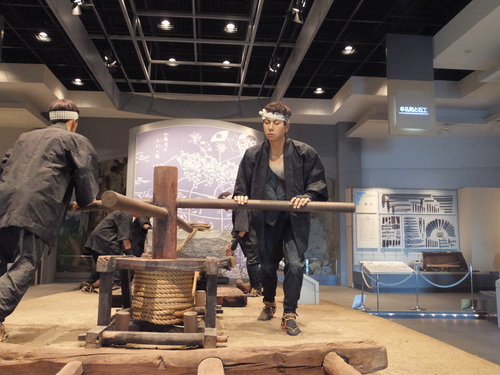
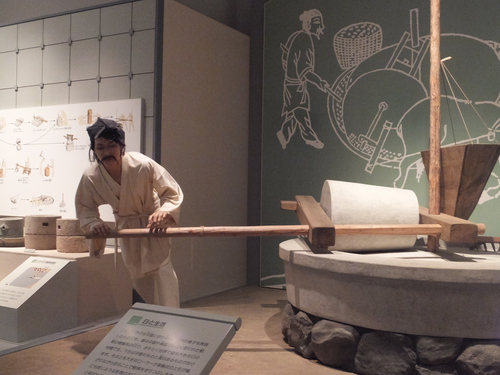
Although there are no English explanations, the displays provide graphic depictions of various aspects of this local industry, which has been passed down faithfully for centuries. These skills developed thanks to a rich quarry of fine granite (Aji-ishi) located not far from the museum.

You can see evidence of the quality of local masons in every stacked stone wall you see in Takamatsu. And there are many of them!

Although the displays are impressive and well worth seeing, I was skeptical as to whether the museum had many visitors. I mean, after you’ve seen the main exhibit once or twice, would you keep coming back?

The receptionist assured me, however, that even in winter they have an average of 100 visitors/day on weekdays and 250 on Saturdays and Sundays, while in the summer holidays they get up to 500 a day. Partly this is due to high quality temporary exhibits, events and concerts. When I visited, they were not only showing Luca’s sculptures but also a great exhibit of papier mache dolls by a famous local craftswoman. And upcoming concerts and workshops were also being advertised.

An even greater draw is the park right in front. What a great place to bring the whole family for a picnic or just to play while enjoying a lovely view of Mt. Yashima! The fact that there is plenty of parking is also helpful.


If you’re looking for some place close to enjoy, both indoors and out, drop into the Takamatsu Stone Museum. For information on access, hours, etc., see the website below:
http://www.yashima-artvillage.jp/english/museum/t_c_stone.html
For more info on Takamatsu:
http://wikitravel.org/en/Takamatsu
http://www.city.takamatsu.kagawa.jp/english/
http://www.my-kagawa.jp/eg/
Other Takamatsu bloggers:
http://pat.ashita-sanuki.jp/
http://ogijima.com

An Italian sculptor resident in Mure, Takamatsu, Luca Roma does amazing things with wood, metal and other materials.

Luca arrived in Japan in 2000 to work with a Japanese sculptor in Ehime. He subsequently moved to Takamatsu where in 2004 he became the first foreign resident to win the Governor’s Award for sculpture.


I found “Thin Lines” warm, inviting, playful, and, at the same time, thought-provoking. As my photos can’t possibly do his work justice, I encourage you to go and see for yourself. The exhibition runs until this Sunday, February 2nd. (For a little more on Luca Roma see:
http://www.yashima-artvillage.jp/english/artist/category06.html#name02 )
While at the museum (entrance fee only 200 yen, under 18 free), you can enjoy a trip into the area’s history of stone quarrying, masonry and sculpture.


Although there are no English explanations, the displays provide graphic depictions of various aspects of this local industry, which has been passed down faithfully for centuries. These skills developed thanks to a rich quarry of fine granite (Aji-ishi) located not far from the museum.

You can see evidence of the quality of local masons in every stacked stone wall you see in Takamatsu. And there are many of them!

Although the displays are impressive and well worth seeing, I was skeptical as to whether the museum had many visitors. I mean, after you’ve seen the main exhibit once or twice, would you keep coming back?

The receptionist assured me, however, that even in winter they have an average of 100 visitors/day on weekdays and 250 on Saturdays and Sundays, while in the summer holidays they get up to 500 a day. Partly this is due to high quality temporary exhibits, events and concerts. When I visited, they were not only showing Luca’s sculptures but also a great exhibit of papier mache dolls by a famous local craftswoman. And upcoming concerts and workshops were also being advertised.

An even greater draw is the park right in front. What a great place to bring the whole family for a picnic or just to play while enjoying a lovely view of Mt. Yashima! The fact that there is plenty of parking is also helpful.


If you’re looking for some place close to enjoy, both indoors and out, drop into the Takamatsu Stone Museum. For information on access, hours, etc., see the website below:
http://www.yashima-artvillage.jp/english/museum/t_c_stone.html
For more info on Takamatsu:
http://wikitravel.org/en/Takamatsu
http://www.city.takamatsu.kagawa.jp/english/
http://www.my-kagawa.jp/eg/
Other Takamatsu bloggers:
http://pat.ashita-sanuki.jp/
http://ogijima.com
Posted by cathy at
14:37
│Comments(0)
2014年01月29日
Negoroji Temple
A belated Happy New Year to all and best wishes for 2014. New Year’s in Japan is traditionally celebrated by a visit to a temple or shrine to pray for good fortune. Takamatsu’s Negoroji Temple is one popular destination, but it’s worth a visit at any time of year.

Those giant straw sandals (waraji) on either side of the gate above are to protect travelers. Made every year by a group of volunteers, they scare off demons. After all, any guardian deity that could carry such a huge pair of sandals would have to be invincible, right?
I liked the way these particular sandals were strung with smaller pairs of sandals.

When Negoroji was established in the late 8th century, mountains were considered the best setting for meditation and prayer, and for honing spiritual powers through rigorous training.

A pilgrim on the 88 temple circuit
Thus, despite being located in Takamatsu city, the temple is set quite deep in a mountain and manages to retain a feeling of remoteness and tranquility. The stairs make for a good workout, too.

Within the temple grounds is the stump of an old Japanese zelkova tree.
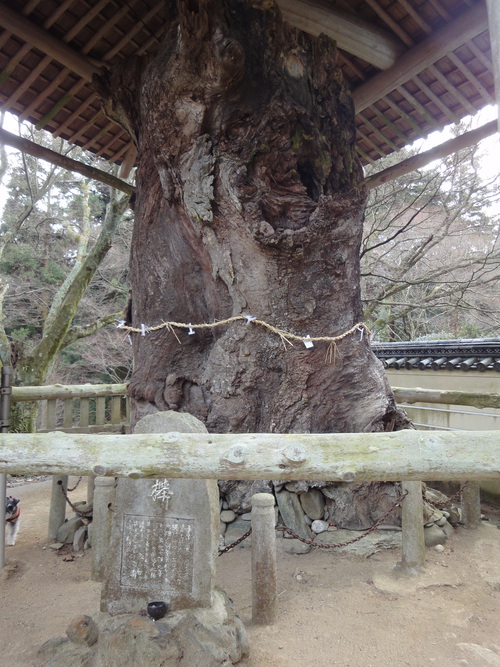
Legend has it that when the Buddhist priest Kobo Daishi (774-835?) founded the temple, a white monkey swung out of this tree to help him. People claim that the tree was 1600 years old when it died and the stump is still highly revered.
Before heading into the main temple, we dutifully cleansed ourselves with water

And bathed ourselves in incense smoke.

We rang the bell for good measure, too, as that seemed to be the thing to do, at least at New Year's anyway. (Please note that not all temple bells can be rung by just anyone who comes by or at any time of day or year.)


Inside the main temple,

we wound our way through lovely, atmospheric corridors, very dimly lit but occasionally opening onto the brilliant light of the temple courtyard. The corridors were lined to the ceiling with carved images of Kannon (Goddess of Mercy).
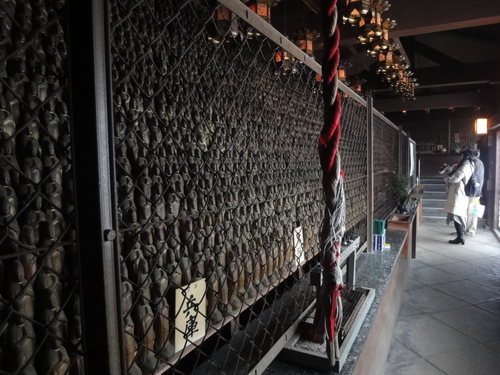
These Kannon statues, by the way, are one way to raise funds to build a temple. Supporters pay to have an image made and placed in the temple when it is built. Over 30,000 images line the corridors of Negoroji, and they come from many different parts of Japan.

Having prayed for a good year, it's tradition to pay 100 yen for a fortune.
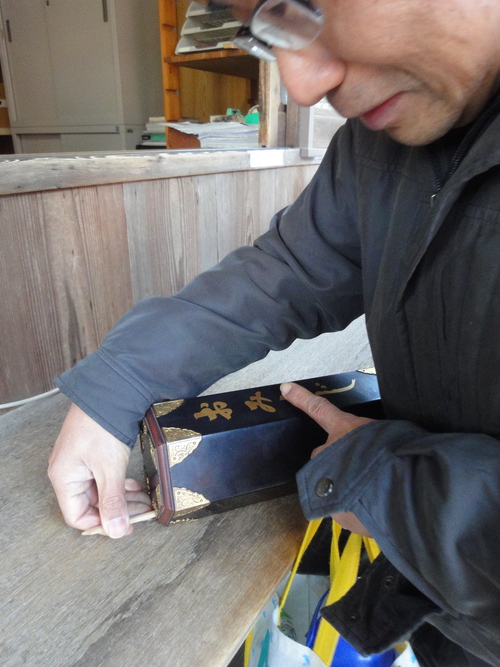
If you get a bad one, don't despair. Just tie it to the branch of a nearby tree to make sure the bad luck doesn't follow you out of the temple. As you can see from the photo below, you won't be the only one.

Car is the easiest way to get to Negoroji Temple. It is a little out of the way but I highly recommend it as does David at http://ogijima.com/negoroji/ .
See map below for access to Negoroji:
http://www.city.takamatsu.kagawa.jp/english/sightseeing/spot/negoroji.html
Takamatsu Access:
Takamatsu can be reached by direct flights from Tokyo’s Haneda Airport, by express bus from Kansai International Airport (3 hr), and by direct flights from China and Korea. It can also be reached by taking the bullet train to Okayama and changing to the Marine Liner bound for Takamatsu (runs every 1/2 hour; takes 1 hour). For more info see http://wikitravel.org/en/Takamatsu
Those giant straw sandals (waraji) on either side of the gate above are to protect travelers. Made every year by a group of volunteers, they scare off demons. After all, any guardian deity that could carry such a huge pair of sandals would have to be invincible, right?
I liked the way these particular sandals were strung with smaller pairs of sandals.
When Negoroji was established in the late 8th century, mountains were considered the best setting for meditation and prayer, and for honing spiritual powers through rigorous training.
A pilgrim on the 88 temple circuit
Thus, despite being located in Takamatsu city, the temple is set quite deep in a mountain and manages to retain a feeling of remoteness and tranquility. The stairs make for a good workout, too.
Within the temple grounds is the stump of an old Japanese zelkova tree.
Legend has it that when the Buddhist priest Kobo Daishi (774-835?) founded the temple, a white monkey swung out of this tree to help him. People claim that the tree was 1600 years old when it died and the stump is still highly revered.
Before heading into the main temple, we dutifully cleansed ourselves with water
And bathed ourselves in incense smoke.
We rang the bell for good measure, too, as that seemed to be the thing to do, at least at New Year's anyway. (Please note that not all temple bells can be rung by just anyone who comes by or at any time of day or year.)
Inside the main temple,
we wound our way through lovely, atmospheric corridors, very dimly lit but occasionally opening onto the brilliant light of the temple courtyard. The corridors were lined to the ceiling with carved images of Kannon (Goddess of Mercy).
These Kannon statues, by the way, are one way to raise funds to build a temple. Supporters pay to have an image made and placed in the temple when it is built. Over 30,000 images line the corridors of Negoroji, and they come from many different parts of Japan.
Having prayed for a good year, it's tradition to pay 100 yen for a fortune.
If you get a bad one, don't despair. Just tie it to the branch of a nearby tree to make sure the bad luck doesn't follow you out of the temple. As you can see from the photo below, you won't be the only one.
Car is the easiest way to get to Negoroji Temple. It is a little out of the way but I highly recommend it as does David at http://ogijima.com/negoroji/ .
See map below for access to Negoroji:
http://www.city.takamatsu.kagawa.jp/english/sightseeing/spot/negoroji.html
Takamatsu Access:
Takamatsu can be reached by direct flights from Tokyo’s Haneda Airport, by express bus from Kansai International Airport (3 hr), and by direct flights from China and Korea. It can also be reached by taking the bullet train to Okayama and changing to the Marine Liner bound for Takamatsu (runs every 1/2 hour; takes 1 hour). For more info see http://wikitravel.org/en/Takamatsu
Posted by cathy at
23:00
│Comments(0)
2013年12月31日
Buskers Festival
Takamatsu City hosts an array of cultural events and festivals that spill out into the streets. A recent addition to this scene is the Buskers Festival, which takes place over a weekend in the fall.
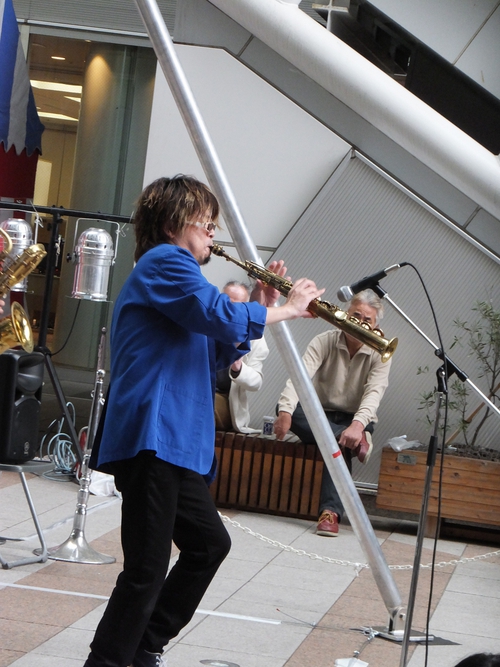
This year it was held on the first weekend in October and I dropped by to see what was happening. I was blown away by the caliber of performances. Featured were top class professional musicians, artists, and circus performers. Many of the acts were not just entertaining, but artful and breathtaking craft. They transformed Sun Port plaza and the shopping arcade into one continuous stage.
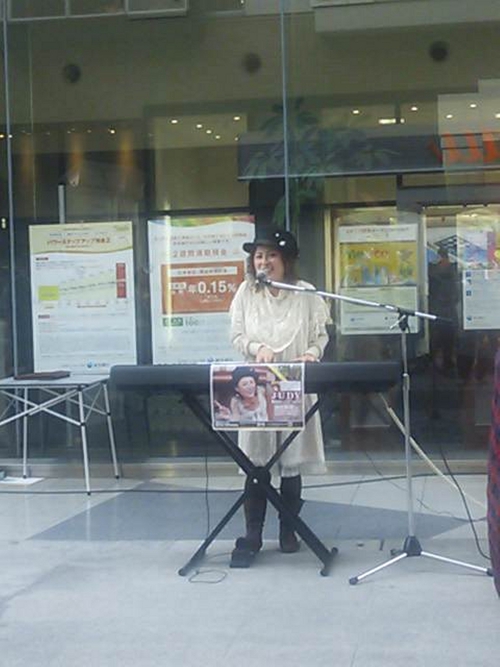
Local singer/songwriter Judy
I started off at Sun Port with HIBI*Chazz-K, a 5-member jazz ensemble, for a half-hour of music that had the crowd swaying and clapping along (a great feat in the land of the reserved Japanese!).


Close by a flea market of toys and children’s clothes was underway. A birdman on stilts spouting steam from his head wove his way among delighted, and sometimes terrified, customers.
Nani-sole and his handcrafted costume
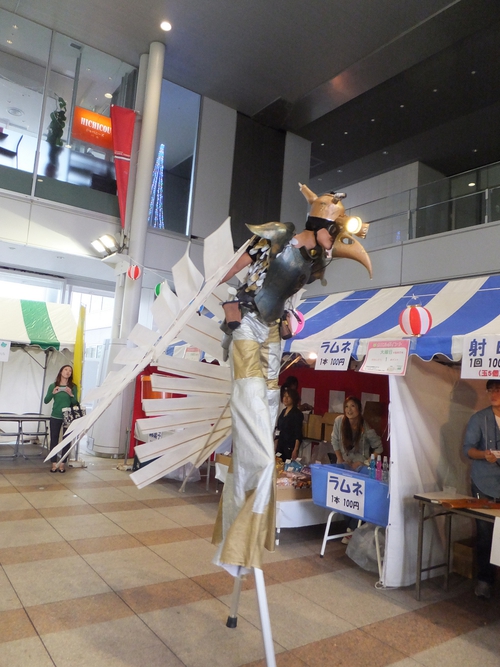

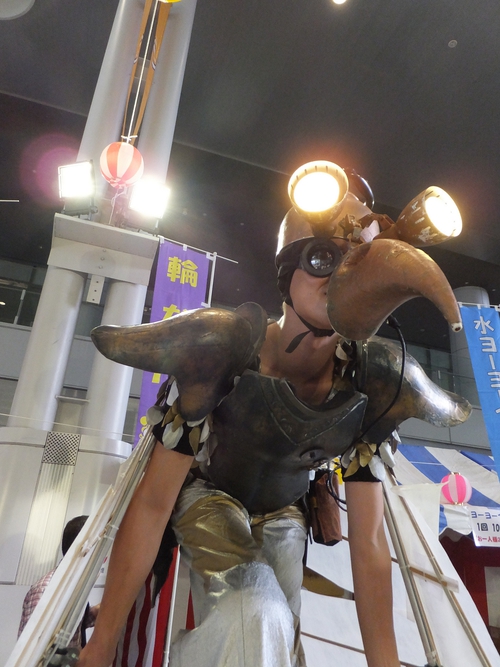
Also close by was Kanako Matsumoto, a Takamatsu native who produced stunning sidewalk art with chalk using skills honed in Florence, Italy.
Kanako’s art
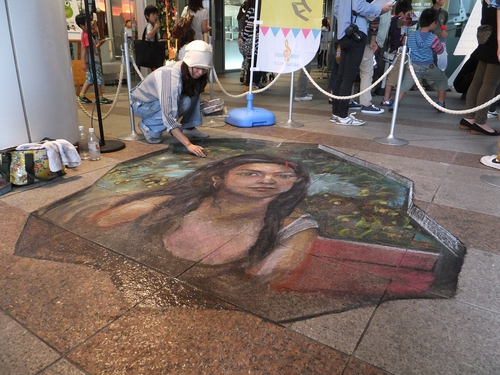
Next on the program was Utsushiomi, a team composed of Kagawa-born aerialist Aimi Hasegawa and juggler Yosuke Meguro. The duo wove a silent whimsical tale punctuated by some heart-stopping acrobatics.
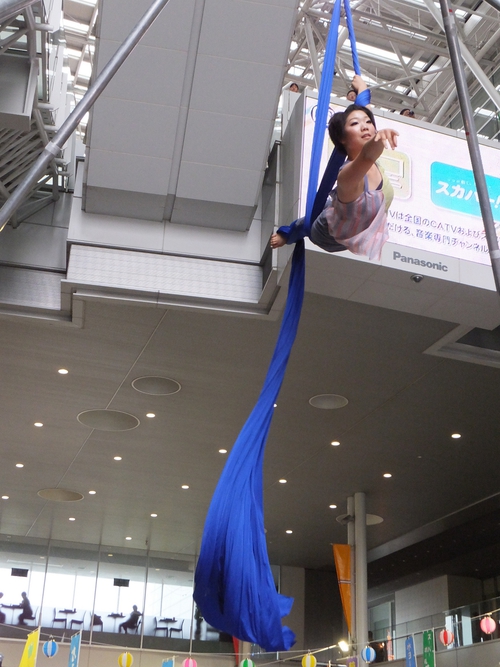

From here, I moved down to the Marugame-machi shopping district to see special guest, French aerial performer Julot who had brought 100 kilograms worth of equipment. I’m glad I saved this for last, because Julot’s performance was spectacular. He really knows how to thrill and captivate a crowd. Beginning with a floor routine of hoops, he managed, like a circus clown, to convince us that he was a just a wee bit clumsy.

Consequently, when he swung himself and his hoops atop a tiny platform perched on an 8-meter pole and tottered about with no lifeline attached, our hearts were in our throats.

Being right below him, I failed utterly to get any good photos but the link below might help you get the picture.
http://www.luganobuskers.ch/2012/julot-fr/
There were 18 acts in all, each one of excellent quality. Hats off to Takamatsu City for putting on such a great show! Definitely watch out for this event next year.
In the meantime, check out the site below for a fascinating discussion of the history and significance of street performing in Japan. http://www.performingarts.jp/E/pre_interview/1006/1.html
Takamatsu Access:
Takamatsu can be reached by direct flights from Tokyo’s Haneda Airport, by express bus from Kansai International Airport (3 hr), and by direct flights from China and Korea. It can also be reached by taking the bullet train to Okayama and changing to the Marine Liner bound for Takamatsu (runs every 1/2 hour; takes 1 hour). For more info see http://wikitravel.org/en/Takamatsu

This year it was held on the first weekend in October and I dropped by to see what was happening. I was blown away by the caliber of performances. Featured were top class professional musicians, artists, and circus performers. Many of the acts were not just entertaining, but artful and breathtaking craft. They transformed Sun Port plaza and the shopping arcade into one continuous stage.
Local singer/songwriter Judy
I started off at Sun Port with HIBI*Chazz-K, a 5-member jazz ensemble, for a half-hour of music that had the crowd swaying and clapping along (a great feat in the land of the reserved Japanese!).


Close by a flea market of toys and children’s clothes was underway. A birdman on stilts spouting steam from his head wove his way among delighted, and sometimes terrified, customers.
Nani-sole and his handcrafted costume



Also close by was Kanako Matsumoto, a Takamatsu native who produced stunning sidewalk art with chalk using skills honed in Florence, Italy.
Kanako’s art

Next on the program was Utsushiomi, a team composed of Kagawa-born aerialist Aimi Hasegawa and juggler Yosuke Meguro. The duo wove a silent whimsical tale punctuated by some heart-stopping acrobatics.


From here, I moved down to the Marugame-machi shopping district to see special guest, French aerial performer Julot who had brought 100 kilograms worth of equipment. I’m glad I saved this for last, because Julot’s performance was spectacular. He really knows how to thrill and captivate a crowd. Beginning with a floor routine of hoops, he managed, like a circus clown, to convince us that he was a just a wee bit clumsy.
Consequently, when he swung himself and his hoops atop a tiny platform perched on an 8-meter pole and tottered about with no lifeline attached, our hearts were in our throats.
Being right below him, I failed utterly to get any good photos but the link below might help you get the picture.
http://www.luganobuskers.ch/2012/julot-fr/
There were 18 acts in all, each one of excellent quality. Hats off to Takamatsu City for putting on such a great show! Definitely watch out for this event next year.
In the meantime, check out the site below for a fascinating discussion of the history and significance of street performing in Japan. http://www.performingarts.jp/E/pre_interview/1006/1.html
Takamatsu Access:
Takamatsu can be reached by direct flights from Tokyo’s Haneda Airport, by express bus from Kansai International Airport (3 hr), and by direct flights from China and Korea. It can also be reached by taking the bullet train to Okayama and changing to the Marine Liner bound for Takamatsu (runs every 1/2 hour; takes 1 hour). For more info see http://wikitravel.org/en/Takamatsu
Posted by cathy at
13:10
│Comments(0)
2013年12月29日
Setouchi Triennale Recap
The verdict is out: Setouchi Triennale 2013 was another resounding success. This year the 108-day contemporary art festival spanned 12 islands plus Takamatsu and Uno ports.
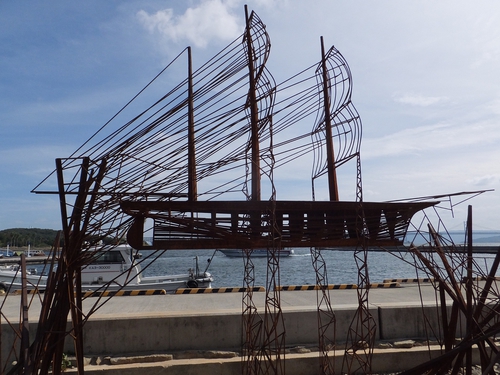
Honjima – Departure by Akira Ishii
According to a report by the Development Bank of Japan, the Triennale attracted 1.07 million visitors (130,000 more than in 2010), and the economic ripple effect is estimated at 13.2 billion yen (up from 11.1 billion yen from 2010). When you consider that the fees charged for access to art sites were extremely low, just the fact that the festival finished in the black is a big accomplishment.
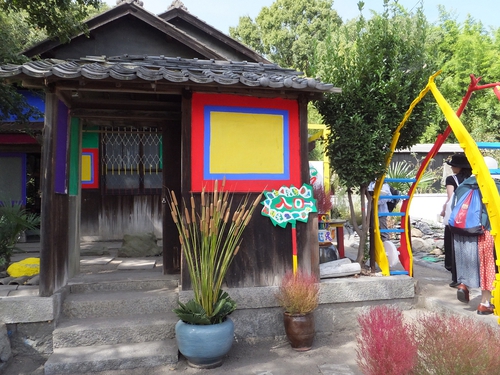
Entrance to Disintegration and Reintegration by Setsuko Mori on Honjima
In addition, the number of artists and islands involved were doubled, and many artists, including a contingent of 100 artists, artisans and performers from Bangladesh, were from overseas.

Prominority member from India on Honjima
According to the General Director, Fram Kitagawa, the number of people in Japan who are hardcore contemporary art fans is at most a few tens of thousands. Yet the Setouchi Triennale drew over a million people. One survey estimated that 1 out of every 100 people in Tokyo had attended.
The Triennale's attraction owes much to the fact that it used contemporary art as a vehicle to entice people to rediscover the islands and a rapidly disappearing way of life.
Kazuko Murao’s Plaster Signboards depicting scenes from the past on Honjima

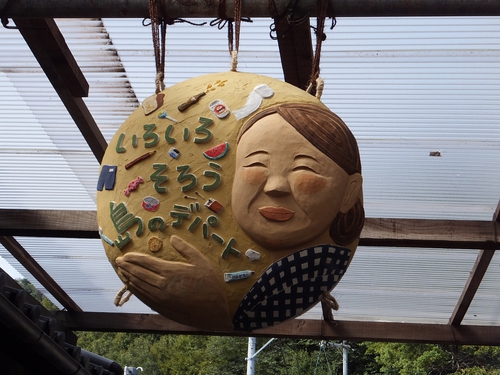
It allowed visitors an escape from the city rat race. It let them experience “slow life” and interact with local people and the natural environment. The response indicates that people in Japan’s urban areas are thirsty for such experience. The fact that 50 percent of visitors from outside Kagawa were women in their twenties and thirties also suggests that going to the Triennale is considered a “cool” thing to do.
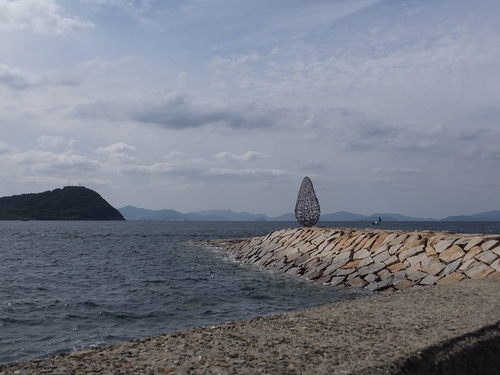
A vine work for Siebold Garden by Karin van de Molin on Honjima
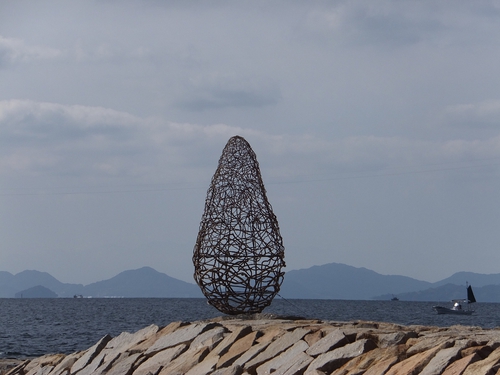
But the true measure of the Triennale’s success must be its effect on the islands and host prefectures. Is it helping to revitalize dying communities? There are no solid data for this yet but I, personally, am hopeful. The residents of those islands that participated in 2010 seemed much more involved in preparations for 2013. Many local “entrepreneurs” stepped up to offer food, accommodation, tours, etc.

Island Soup Honjima by EAT & ART TARO
(I loved this inclusion of new foods made with locally grown ingredients as art!)
A substantial number of local volunteer organizations and companies became enthusiastically involved. The artists also found many ways to involve the local people. The artists’ interpretations of island life, history and nature helped residents see their islands anew, while interaction with many appreciative visitors gave them a glimpse of their area’s potential and hope for the future.


Tinnitus by Jun Homma on Honjima
In addition to site-specific works, most communities also hosted ongoing projects, which are designed to help local residents explore and direct their community’s future. But for me, perhaps the most promising sign was that 3 families from the tiny island of Ogijima were inspired by the Triennale to return with their children. The school, which has been closed for many years, will reopen next year.
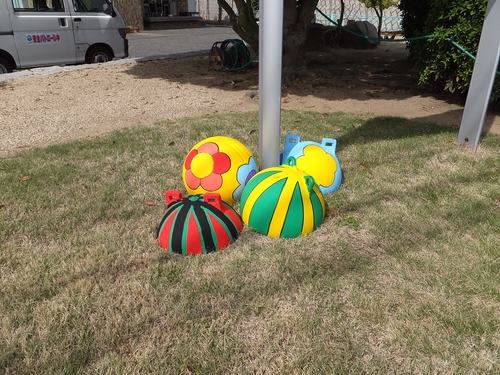
Local buoy art by school children on Honjima
Don’t despair if you missed Setouchi Triennale 2013. Many of the sites are still open to visitors (see http://setouchi-artfest.jp/en/ for more information) and Takamatsu is an ideal base for traveling to the many islands. Just be sure to mark 2016, the year of the next Triennale, on your calendar.
Takamatsu Access:
Takamatsu can be reached by direct flights from Tokyo’s Haneda Airport, by express bus from Kansai International Airport (3 hr), and by direct flights from China and Korea. It can also be reached by taking the bullet train to Okayama and changing to the Marine Liner bound for Takamatsu (runs every 1/2 hour; takes 1 hour). For more info see http://wikitravel.org/en/Takamatsu

Honjima – Departure by Akira Ishii
According to a report by the Development Bank of Japan, the Triennale attracted 1.07 million visitors (130,000 more than in 2010), and the economic ripple effect is estimated at 13.2 billion yen (up from 11.1 billion yen from 2010). When you consider that the fees charged for access to art sites were extremely low, just the fact that the festival finished in the black is a big accomplishment.

Entrance to Disintegration and Reintegration by Setsuko Mori on Honjima
In addition, the number of artists and islands involved were doubled, and many artists, including a contingent of 100 artists, artisans and performers from Bangladesh, were from overseas.

Prominority member from India on Honjima
According to the General Director, Fram Kitagawa, the number of people in Japan who are hardcore contemporary art fans is at most a few tens of thousands. Yet the Setouchi Triennale drew over a million people. One survey estimated that 1 out of every 100 people in Tokyo had attended.
The Triennale's attraction owes much to the fact that it used contemporary art as a vehicle to entice people to rediscover the islands and a rapidly disappearing way of life.
Kazuko Murao’s Plaster Signboards depicting scenes from the past on Honjima


It allowed visitors an escape from the city rat race. It let them experience “slow life” and interact with local people and the natural environment. The response indicates that people in Japan’s urban areas are thirsty for such experience. The fact that 50 percent of visitors from outside Kagawa were women in their twenties and thirties also suggests that going to the Triennale is considered a “cool” thing to do.

A vine work for Siebold Garden by Karin van de Molin on Honjima

But the true measure of the Triennale’s success must be its effect on the islands and host prefectures. Is it helping to revitalize dying communities? There are no solid data for this yet but I, personally, am hopeful. The residents of those islands that participated in 2010 seemed much more involved in preparations for 2013. Many local “entrepreneurs” stepped up to offer food, accommodation, tours, etc.

Island Soup Honjima by EAT & ART TARO
(I loved this inclusion of new foods made with locally grown ingredients as art!)
A substantial number of local volunteer organizations and companies became enthusiastically involved. The artists also found many ways to involve the local people. The artists’ interpretations of island life, history and nature helped residents see their islands anew, while interaction with many appreciative visitors gave them a glimpse of their area’s potential and hope for the future.


Tinnitus by Jun Homma on Honjima
In addition to site-specific works, most communities also hosted ongoing projects, which are designed to help local residents explore and direct their community’s future. But for me, perhaps the most promising sign was that 3 families from the tiny island of Ogijima were inspired by the Triennale to return with their children. The school, which has been closed for many years, will reopen next year.

Local buoy art by school children on Honjima
Don’t despair if you missed Setouchi Triennale 2013. Many of the sites are still open to visitors (see http://setouchi-artfest.jp/en/ for more information) and Takamatsu is an ideal base for traveling to the many islands. Just be sure to mark 2016, the year of the next Triennale, on your calendar.
Takamatsu Access:
Takamatsu can be reached by direct flights from Tokyo’s Haneda Airport, by express bus from Kansai International Airport (3 hr), and by direct flights from China and Korea. It can also be reached by taking the bullet train to Okayama and changing to the Marine Liner bound for Takamatsu (runs every 1/2 hour; takes 1 hour). For more info see http://wikitravel.org/en/Takamatsu
Posted by cathy at
07:59
│Comments(0)
2013年11月30日
Takamijima Continued
Here, finally, is my sequel to the article on Takamijima, an island highlighted during the autumn session of the Setouchi Triennale 2013.

Visitors to the island were greeted by yellow flags, perhaps as a reminder of the pyrethrums once cultivated on the hill. Created by several thousand school age children (elementary through senior high) in the Tadotsu district, the flags flapping in the wind sounded like applause.
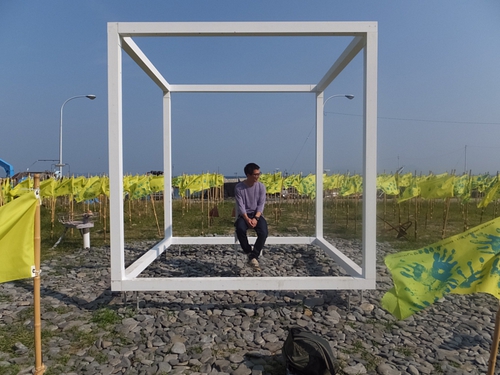
The settlement of Takamijima dates back to the 12th century when an entire community moved there from Okayama.

As you can see from the photo above, the island is far too steep for farming so why would people have chosen to live there? Perhaps because they could make a good living shipping cargo instead, like residents of so many of the Shiwaku islands.
The island’s shape was captured by Toshiro Komatsu’s “Sea Room”, a 3D rendition of the island using glass jars filled with seawater

and organisms.

Records from 1713 indicate that wooden cargo vessels accounted for 75 percent of the boats on the island whereas only 25 percent were fishing boats. By the late 18th century, however, that had changed, and fishing had become the main industry. That is still true today. The islanders farm Tai (sea bream) and Hamachi (yellowtail). They also catch sea lance and octopi. Ohji Yoshino’s House of Octopus provided a humorous representation of this aspect of island life.

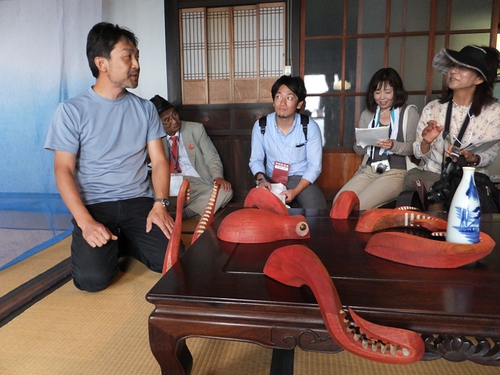
The artist explaining his work.
The steep hill makes the one remaining village a great lookout spot.

Architect Masahito Nomura took advantage of this when he transformed a beautiful old house into a terrace restaurant.

The panoramic view achieved with mirrors was a nice added touch.

The corner tiles on the garden walls were zodiac animal motifs. Although sadly the worse for wear, they were endearing nevertheless, such as this earless hare and hornless ox that appear to be comforting one another.

The house itself was transformed into a gallery


To end our trip, we made a quick dash to the Itamochi Village Restoration Project, a 10-minute bike ride and 5-minute very steep hike. The last person living in this village left 7 years ago, and the project was a forewarning of what may lie ahead for the other village.
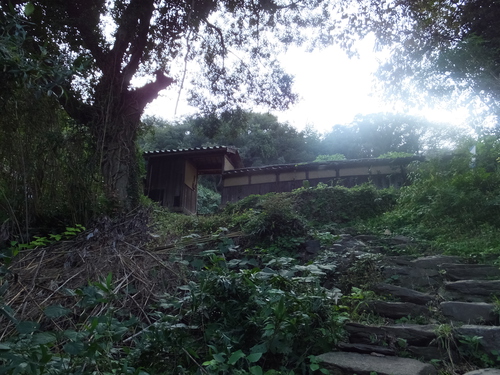
As we were leaving, however, a staff member told us that despite the island’s rapidly dwindling population, the islanders have decided to participate in the next Triennale in 2016. A small ray of hope for the village.

Takamatsu Access:
Takamatsu can be reached by direct flights from Tokyo’s Haneda Airport, by express bus from Kansai International Airport (3 hr), and by direct flights from China and Korea. It can also be reached by taking the bullet train to Okayama and changing to the Marine Liner bound for Takamatsu (runs every 1/2 hour; takes 1 hour). For more info see http://wikitravel.org/en/Takamatsu
タグ :Takamijima
Posted by cathy at
00:44
│Comments(0)
2013年11月28日
Magic Gold
If you’ve read this blog before, you will know that I love Ritsurin, a traditional Japanese garden covering 75 hectares in the middle of Takamatsu. At this time of year, Ritsurin hosts its autumn leaf viewing festival, an event that has continued for the last 12 years.
The garden is illuminated until 9PM, allowing visitors to enjoy the beauty of the colored leaves and deep green evergreens shimmering in the night.


On the weekend, concerts and food stalls add to the festivities. This year the festival runs until Sunday evening, December 1. If you have the chance to go, I highly recommend it. While you're there, take a punt ride on the pond.
As a Ritsurin Garden fan, it is always a delight to discover something new. My latest find is those jagged rocks sticking out of the pond in the far left of the photo below.
Those are no ordinary rocks. Traditional Japanese garden design was heavily influenced by the Chinese, and Ritsurin likewise contains many allusions to Chinese philosophy. Those rocks represent an island located far across the sea, which in ancient Shinxian mythology was believed to house immortals. Twice a year—a month before the winter solstice and a month after—these stones turn to gold.
This phenomenon was first noticed by volunteer guides while taking visitors across the bridge just as the sun was sinking behind the hill. Hearing cries of surprise, they turned to see the rocks shining like gold. Rumors of this phenomenon began spreading about 4 years ago, but not many people manage to be in the right place at the right time. The foot of an ancient tree in the teahouse garden also turns gold.
This little bit of magic is caused by a glass covered building outside the park. At just the right time of year, it catches the rays of the sinking sun and reflects gold light into the garden. I have always thought the few buildings visible from the garden ruin the view. Although I still hope that they will be removed some day, twice a year I will forgive them for being there. This special “light show” lasts only 4 minutes and occurs around November 22 and January 22 between 3:30PM and 4 PM.
(Many thanks to Hiroko who caught the "show" on camera.)
Takamatsu Access:
Takamatsu can be reached by direct flights from Tokyo’s Haneda Airport, by express bus from Kansai International Airport (3 hr), and by direct flights from China and Korea. It can also be reached by taking the bullet train to Okayama and changing to the Marine Liner bound for Takamatsu (runs every 1/2 hour; takes 1 hour). For more info see http://wikitravel.org/en/Takamatsu
タグ :Ritsurin Garden
Posted by cathy at
23:02
│Comments(0)
2013年10月30日
Takamijima
Takamijima is one of 3 islands that joined the Setouchi Triennale for the autumn session. Of all the islands involved in this contemporary art festival, this one is most clearly on the brink of extinction. In its heyday (16th to 18th century), it was populated by close to 1500 people but now there are only 53 left, and most of them are elderly.

Many of the contemporary art installations did a great job of capturing the island’s history and current reality, using materials at hand. One example is House of Pyrethrum. Pyrethrum is a type of chrysanthemum and natural insecticide that was used to make mosquito coils and its cultivation was once a thriving industry on Takajima.
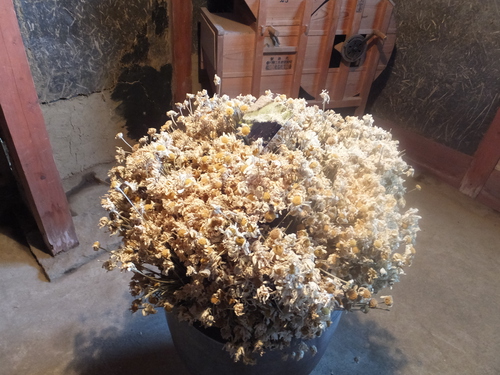
Dried pyrethrum flowers
One elderly resident said she used to climb to the top of the steep island peak every day after school to help bring in the harvest of flowers. That’s quite a climb! You can see the hill and the workers with back racks in the photo of the installation below.

The flowers were then dried and exported off the island for processing. In honor of this lost industry, House of Pyrethrum used every part of the flower – the petals, pistons, etc. – and spread them out over black-lacquered surfaces to produce two striking works. Each square in the photo above and the circle below are made with a different part of the flower. They are spread loose on the surface so don't sneeze near them.

In the loft, the team made a spiral of mosquito cones and burned one a day.

The village on the hill is extremely picturesque and the homes and stone ramparts on which they are built attest to the skill of the Shiwaku carpenters that lived here. The stonewalls and some of the homes as well date back to the Edo period (17th to 19th century).
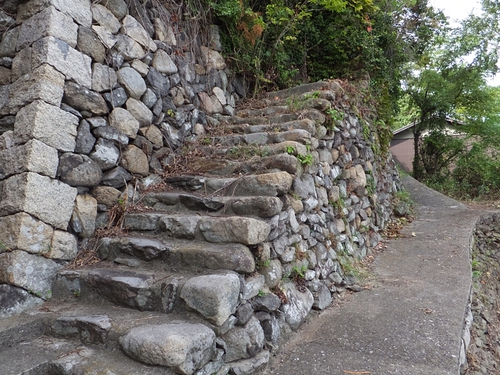

But most of the homes are abandoned. Kayako Nakashima captured the beauty and the decay in her aptly named Transition House.

Here she is explaining the work. She told us that when she first entered an abandoned building, she noticed that the darkness was pierced by pinpoints of light where insects had eaten holes in the wall. Inspired by the beauty of it, she bored hundreds of holes in the walls and roof and filled them with acrylic rods. The effect is quite awe-inspiring.
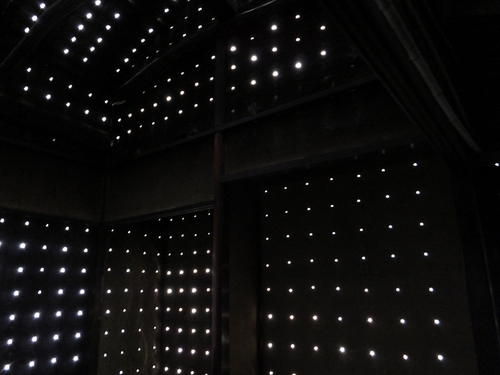
As you can see, this island really captured my imagination, but I am out of space and time so I will continue this in my next post.
For more on the Triennale, see http://setouchi-artfest.jp/en/
Takamatsu Access:
Takamatsu can be reached by direct flights from Tokyo’s Haneda Airport, by express bus from Kansai International Airport (3 hr), and by direct flights from China and Korea. It can also be reached by taking the bullet train to Okayama and changing to the Marine Liner bound for Takamatsu (runs every 1/2 hour; takes 1 hour). For more info see http://wikitravel.org/en/Takamatsu

Many of the contemporary art installations did a great job of capturing the island’s history and current reality, using materials at hand. One example is House of Pyrethrum. Pyrethrum is a type of chrysanthemum and natural insecticide that was used to make mosquito coils and its cultivation was once a thriving industry on Takajima.

Dried pyrethrum flowers
One elderly resident said she used to climb to the top of the steep island peak every day after school to help bring in the harvest of flowers. That’s quite a climb! You can see the hill and the workers with back racks in the photo of the installation below.

The flowers were then dried and exported off the island for processing. In honor of this lost industry, House of Pyrethrum used every part of the flower – the petals, pistons, etc. – and spread them out over black-lacquered surfaces to produce two striking works. Each square in the photo above and the circle below are made with a different part of the flower. They are spread loose on the surface so don't sneeze near them.

In the loft, the team made a spiral of mosquito cones and burned one a day.

The village on the hill is extremely picturesque and the homes and stone ramparts on which they are built attest to the skill of the Shiwaku carpenters that lived here. The stonewalls and some of the homes as well date back to the Edo period (17th to 19th century).


But most of the homes are abandoned. Kayako Nakashima captured the beauty and the decay in her aptly named Transition House.

Here she is explaining the work. She told us that when she first entered an abandoned building, she noticed that the darkness was pierced by pinpoints of light where insects had eaten holes in the wall. Inspired by the beauty of it, she bored hundreds of holes in the walls and roof and filled them with acrylic rods. The effect is quite awe-inspiring.

As you can see, this island really captured my imagination, but I am out of space and time so I will continue this in my next post.
For more on the Triennale, see http://setouchi-artfest.jp/en/
Takamatsu Access:
Takamatsu can be reached by direct flights from Tokyo’s Haneda Airport, by express bus from Kansai International Airport (3 hr), and by direct flights from China and Korea. It can also be reached by taking the bullet train to Okayama and changing to the Marine Liner bound for Takamatsu (runs every 1/2 hour; takes 1 hour). For more info see http://wikitravel.org/en/Takamatsu
Posted by cathy at
17:10
│Comments(0)
2013年10月28日
Awashima Snapshots
Takamatsu makes a great base for enjoying islands and art in the Setouchi Triennale. The final week of this contemporary art festival has been fair and beautiful. I spent these last lovely days joining the hordes of visitors to the 3 islands only open during the Autumn Session. There is far, far too much to see and enjoy, so I will content myself here with sharing just a few snapshots. Let me start with Awashima.

9 AM waiting with several hundred people for a boat that carries only 70 passengers – a great time to chat and make friends.

The boats are crowded but friendly.
Recognizing that the point of this contemporary art festival is to enjoy the islands, we decided to forgo waiting in line with the hordes to see manmade art and instead climbed the peak behind the village to see nature’s art. At 220 meters it was a stiff half-hour climb

and we were hot and sweaty at the top despite the cool autumn weather.

But we had been lured by promises of the 360-degree view and we were not disappointed. The shot below shows Takamajima, the next island on our itinerary.
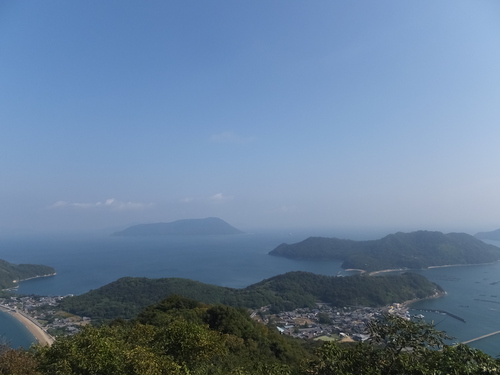
Back at the bottom, we stopped at an art site or two, much less crowded because most people had passed on. The work, Susanoo, which is like walking into a dark cobwebby cave on the first floor, caught my fancy.
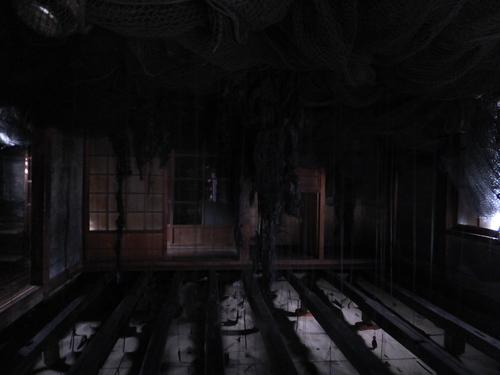
I particularly enjoyed the “art” on the second floor – the thrifty habit of long deceased residents of patching their doors with used letters and newspapers resulted in gorgeous collages that gave the room a nostalgic feel.


Here’s another door that caught my fancy.

Made from a single tree trunk that has been split open like a book. Yes, I know it’s not contemporary art but it is part of the “art” of living and as such is most relevant to this art festival. The Triennale uses art as a vehicle to draw people’s attention to the beauty of what is already there.
Here’s another form of art that you won’t find in most contemporary art exhibits. Homemade sandwiches and gingerale.
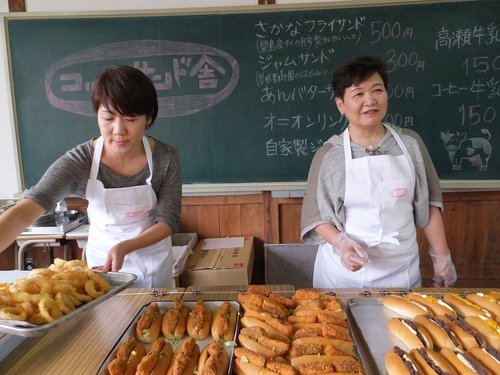

Delicious but how is it art? The food designer and creator studied the area’s products and cuisine, revived a much loved bread roll and stuffed it with local ingredients: freshly caught, deep fried fish fillets and tartar sauce, and cream cheese with either sweet bean jam or marmalade made with locally grown oranges. Mmmm. The “artist’s” goal was to capture people’s hearts and imaginations through their stomachs and she did a good job. The food was all served on tin dishes from the school.
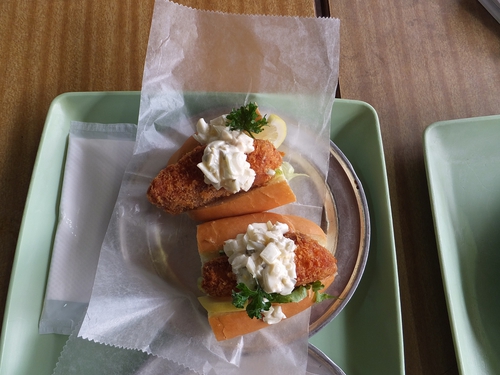
I had been fortunate to try her “art” early in the season before the crowds. In this last week, however, people were lining up for an hour ahead of time to get some, so we opted to enjoy the fare offered at the many booths put up by local chambers of commerce, women’s organizations, young entrepreneurs and others. My favorite was tempura dried anchovies produced by a mother and son from Ibukijima island where anchovy production is the main industry.
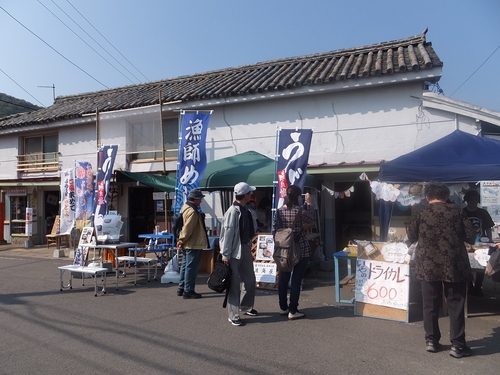
All in all, it was a great way to spend the morning, and we could have stayed all day. The islanders were very open and friendly. They seemed more accustomed to visitors than the other islands, perhaps because the former marine school had students boarding from all over Japan, and many of the local sailors traveled the world. Here are some parting shots.

The old marine school
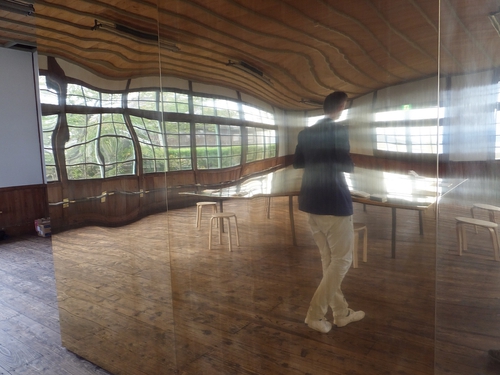
The Sea Library with the artist reflected in the locally made brass partition.
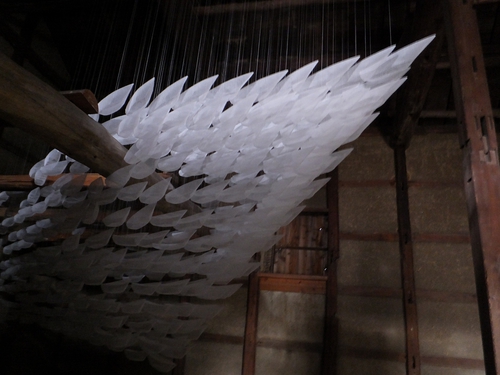
Embarkation, in which artist Syoko Aso expressed her hopes for the islanders to sail on into the future.
For more on the Triennale, see http://setouchi-artfest.jp/en/
Takamatsu Access:
Takamatsu can be reached by direct flights from Tokyo’s Haneda Airport, by express bus from Kansai International Airport (3 hr), and by direct flights from China and Korea. It can also be reached by taking the bullet train to Okayama and changing to the Marine Liner bound for Takamatsu (runs every 1/2 hour; takes 1 hour). For more info see http://wikitravel.org/en/Takamatsu

9 AM waiting with several hundred people for a boat that carries only 70 passengers – a great time to chat and make friends.

The boats are crowded but friendly.
Recognizing that the point of this contemporary art festival is to enjoy the islands, we decided to forgo waiting in line with the hordes to see manmade art and instead climbed the peak behind the village to see nature’s art. At 220 meters it was a stiff half-hour climb

and we were hot and sweaty at the top despite the cool autumn weather.

But we had been lured by promises of the 360-degree view and we were not disappointed. The shot below shows Takamajima, the next island on our itinerary.

Back at the bottom, we stopped at an art site or two, much less crowded because most people had passed on. The work, Susanoo, which is like walking into a dark cobwebby cave on the first floor, caught my fancy.

I particularly enjoyed the “art” on the second floor – the thrifty habit of long deceased residents of patching their doors with used letters and newspapers resulted in gorgeous collages that gave the room a nostalgic feel.


Here’s another door that caught my fancy.

Made from a single tree trunk that has been split open like a book. Yes, I know it’s not contemporary art but it is part of the “art” of living and as such is most relevant to this art festival. The Triennale uses art as a vehicle to draw people’s attention to the beauty of what is already there.
Here’s another form of art that you won’t find in most contemporary art exhibits. Homemade sandwiches and gingerale.


Delicious but how is it art? The food designer and creator studied the area’s products and cuisine, revived a much loved bread roll and stuffed it with local ingredients: freshly caught, deep fried fish fillets and tartar sauce, and cream cheese with either sweet bean jam or marmalade made with locally grown oranges. Mmmm. The “artist’s” goal was to capture people’s hearts and imaginations through their stomachs and she did a good job. The food was all served on tin dishes from the school.

I had been fortunate to try her “art” early in the season before the crowds. In this last week, however, people were lining up for an hour ahead of time to get some, so we opted to enjoy the fare offered at the many booths put up by local chambers of commerce, women’s organizations, young entrepreneurs and others. My favorite was tempura dried anchovies produced by a mother and son from Ibukijima island where anchovy production is the main industry.

All in all, it was a great way to spend the morning, and we could have stayed all day. The islanders were very open and friendly. They seemed more accustomed to visitors than the other islands, perhaps because the former marine school had students boarding from all over Japan, and many of the local sailors traveled the world. Here are some parting shots.

The old marine school

The Sea Library with the artist reflected in the locally made brass partition.

Embarkation, in which artist Syoko Aso expressed her hopes for the islanders to sail on into the future.
For more on the Triennale, see http://setouchi-artfest.jp/en/
Takamatsu Access:
Takamatsu can be reached by direct flights from Tokyo’s Haneda Airport, by express bus from Kansai International Airport (3 hr), and by direct flights from China and Korea. It can also be reached by taking the bullet train to Okayama and changing to the Marine Liner bound for Takamatsu (runs every 1/2 hour; takes 1 hour). For more info see http://wikitravel.org/en/Takamatsu
Posted by cathy at
12:46
│Comments(5)
2013年09月30日
Wasen Finale
The summer session of the Setouchi Triennale ended over a month ago but there is one event that still deserves mentioning: the launching of the tenmasen, a wooden cargo boat traditional to the Setouchi region.

The product of the Triennale summer session, the boat was built by the 3-man team of Douglas Brooks, Koji Matono and Takumi Suzuki in public view, evolving into a real beauty that drew much attention to this swiftly vanishing art. The project dovetailed perfectly with the Triennale’s theme of rediscovering and reviving the precious heritage of this beautiful region.
(For more on the project see Douglas’ blog: http://blog.douglasbrooksboatbuilding.com/ ).
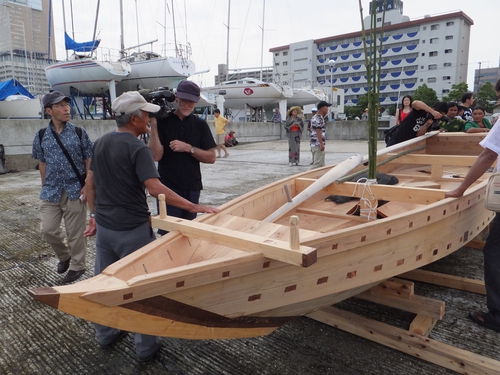
I personally loved the decorative touch of copper plate covering the nail heads and end grain. Looks like a great way to cover up any dents inadvertently made by a hammer, too.
There had been some doubt as to whether the boat would ever really be launched due to red tape and rules. Even when those were overcome, an approaching typhoon threatened to ruin the party. August 30, however, dawned surprisingly fair and about 100 people gathered at Takamatsu’s yacht club to see the boat make its maiden voyage.
Speeches were made and the name “Hoyu” (friendship) was unveiled

Douglas officiated the ceremony, following ancient customs learned from a local 84-year-old boat builder.

Symbolic offerings included ancient coins, a pair of die, figures of a man and woman,

and a fish made of fishing net by The Skin Project.
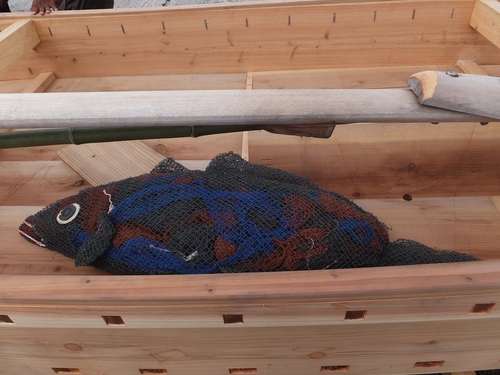
Douglas explained the significance of each but not having a pen and paper I have now forgotten!
Music was provided by Bengali performers using traditional instruments

And by a musical contraption from MEGI HOUSE.

A fanfare of conch shells also joined the chorus.

The tenmasen was carried into the water by a team of hefty university students
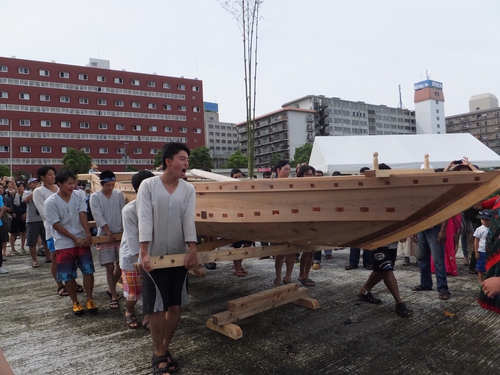
and turned 3 times.
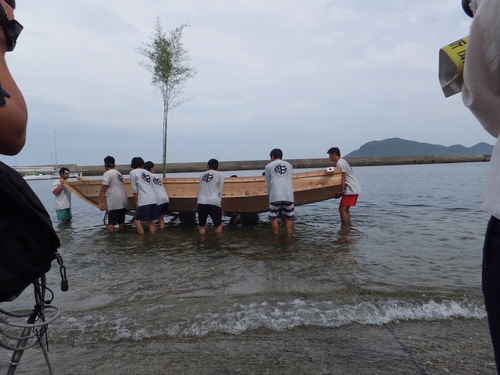
The students then danced what looked like the All Blacks Haka War Dance with a Bengali chant. Very impressive.
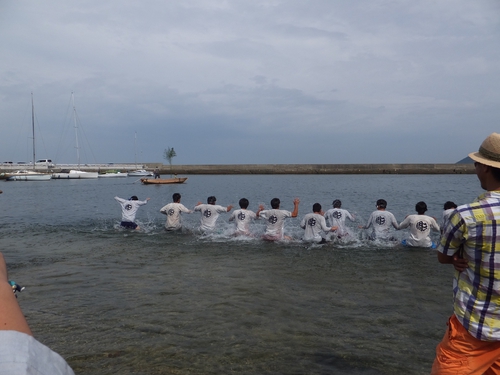
Douglas meanwhile set off to sea, picking up passengers along the way.

A flotilla of canoes joined the party, taking anyone who wanted for a ride.

One of those was me of course. Hearing that I was from Canada and had been paddling since I was seven, my guide very kindly let me take over from him and stern the canoe. (That's me in the back of the green canoe below.)

All in all, the ceremony was a wonderful celebration of diversity, friendship, and the common bond of love for good craftsmanship and beauty. It was also a great demonstration of the power of the Triennale to transform Takamatsu and the Setouchi region into a hub of intercultural exchange and understanding.
For more on the Triennale, see http://setouchi-artfest.jp/en/
Takamatsu Access:
Takamatsu can be reached by direct flights from Tokyo’s Haneda Airport, by express bus from Kansai International Airport (3 hr), and by direct flights from China and Korea. It can also be reached by taking the bullet train to Okayama and changing to the Marine Liner bound for Takamatsu (runs every 1/2 hour; takes 1 hour). For more info see http://wikitravel.org/en/Takamatsu
Posted by cathy at
15:00
│Comments(0)
2013年09月30日
Megijima Musings
I am very behind on my blog again, due to a massive deadline. Fortunately, I finished just in time for the start of the Setouchi Triennale Autumn Session. Yay!
In this post, let me revisit Megijima. Just 20 minutes by ferry from Takamatsu Port, the island’s beautiful beach, great fishing, and fantastic views make it a popular summer destination, at least for people from Kagawa.
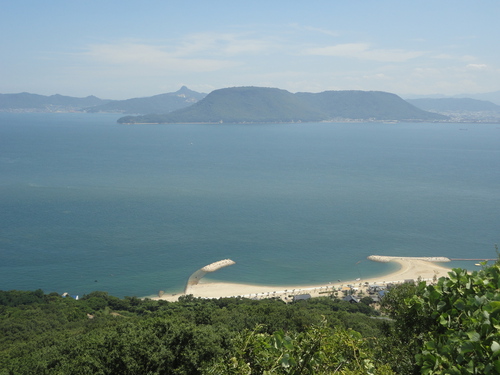
Looking down from the top of Megijima
It also has an impressive network of manmade caves at the top of one of its two steep hills. These caves, most likely made by pirates, were commandeered for the tourist trade many decades ago. Locals began advertising the spot as the former haunt of an ogre band defeated by the boy-hero Momotaro in a popular folktale.

Far below the caves, high stonewalls called ohte protect the village from being ravaged by winter storms.
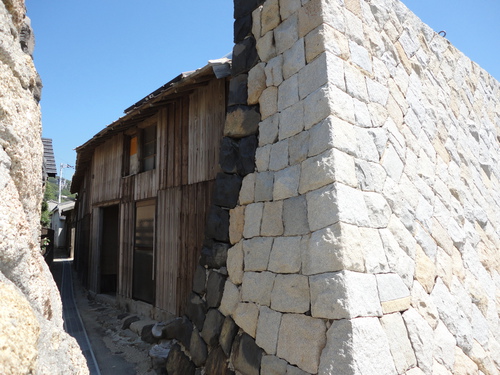
But a walk through the narrow lanes makes it clear that the island community has still been ravaged by the sea of time. Abandoned homes in various stages of decay abound, such as the one below, the roof of which appears to be fastened down with a net of bungee cords.

The Triennale, as you may know, aims to revitalize the islands, using art as a tool to highlight local charms and potential and get people involved. The Oni no Ko (Ogre Kids) Project for 2013 on Megijima is a good example of that involvement.
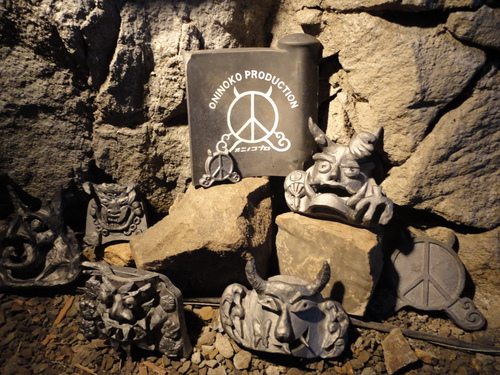
Over 3,000 junior high school students from schools throughout the prefecture made Onigawara (ogre tiles traditionally used to decorate Japanese roofs). The cave is filled with their crazy creations, nicely accented by Philipp Artus’s video installations.
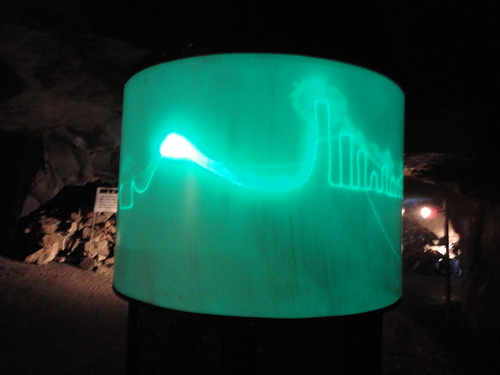
This project alone must be drawing many families to the island to see their kids’ creations. And they are being joined by visitors from all over Japan. (Admission JPY 500. JPY 300 with a Triennale Passport.)
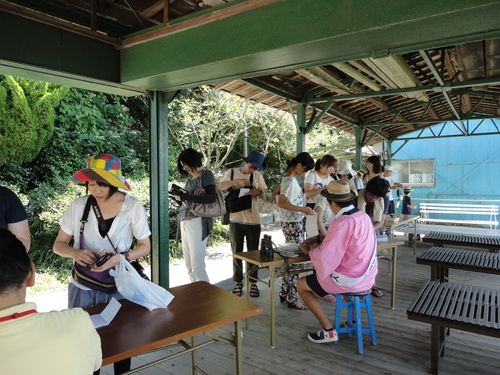
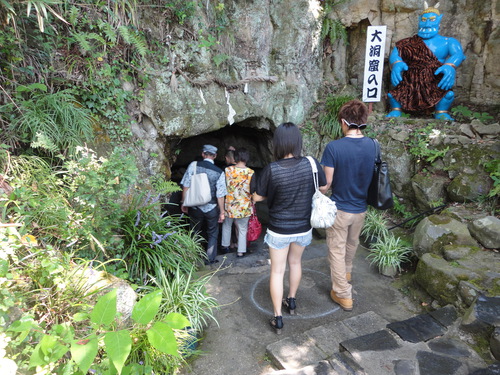
Another popular attraction is MEKON, a new work by Shinro Ohtake (admission JPY500. Free with Triennale Passport). Some people reportedly came to the Triennale just to see his creations. MEKON is a collage of colorful ‘junk’, the detritus of modern life. According to the guides, the work represents ‘life force’ and ‘regeneration’.

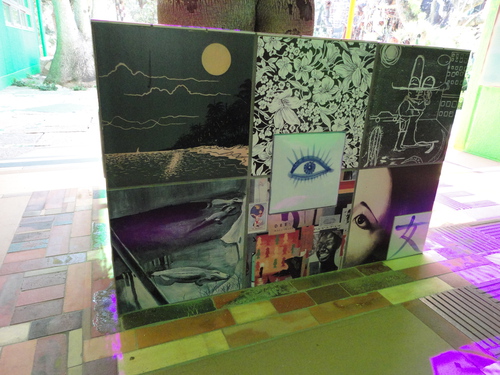
I personally loved the way Ohtake uses vegetation as part of this collage, letting nature take over the work.


I also found it promising to see several new businesses cropping up. One was a diner, serving very simple but affordable fare and run by a local family…

Oni no Daidokoro (Ogres' Kitchen)

Another was this food stall run by Kaji, a young woman from off the island. She had the novel idea of renting wall space on her homemade stall for advertising and using the proceeds to run her business (a pita sandwich and ice cream stall). It will be great if such initiatives continue to grow and spread like the plants taking over Ohtake’s MEKON.
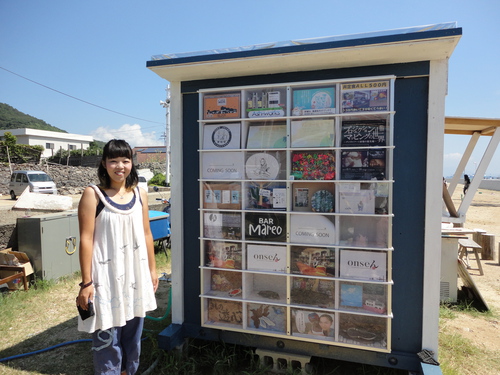
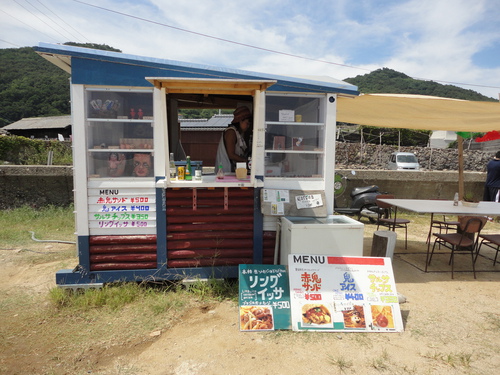
There is plenty more to see on Megijima. For more on the Triennale, see http://setouchi-artfest.jp/en/
Takamatsu Access:
Takamatsu can be reached by direct flights from Tokyo’s Haneda Airport, by express bus from Kansai International Airport (3 hr), and by direct flights from China and Korea. It can also be reached by taking the bullet train to Okayama and changing to the Marine Liner bound for Takamatsu (runs every 1/2 hour; takes 1 hour). For more info see http://wikitravel.org/en/Takamatsu
Posted by cathy at
12:00
│Comments(0)
2013年08月31日
Art on Ibukijima
I had the good fortune to visit Ibukijima before the start of the summer session of the Setouchi Triennale 2013. I went to observe a workshop by Mikan-gumi and the Sogabe Lab (Kanagawa University).

View from Mikan/Sogabe Lab site
This team of architects and students, led by Masashi Sogabe, has been involved in various experimental architectural projects for the reconstruction of communities devastated by the 2011 tsunami in northeastern Japan. They are applying this experience to the project on Ibukijima, a community that is being rapidly eroded by depopulation and aging. The project is temporarily housed in the unused fish processing plant in the photo below.
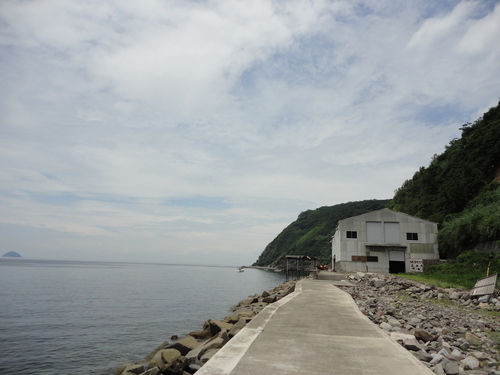
The team’s first step was to walk the entire island and then reproduce it as a model.

Every household was visited and invited to take part in the next step, the collection of memories. At the workshop, islanders shared memories of places that have disappeared,
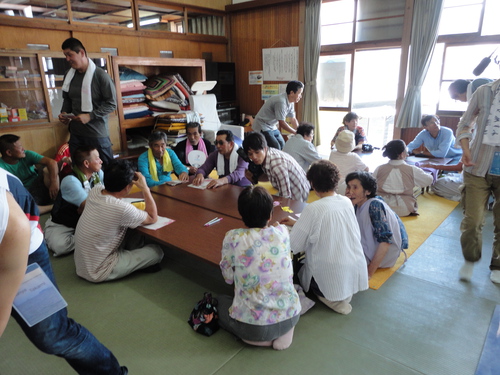
writing the names of these places on flags
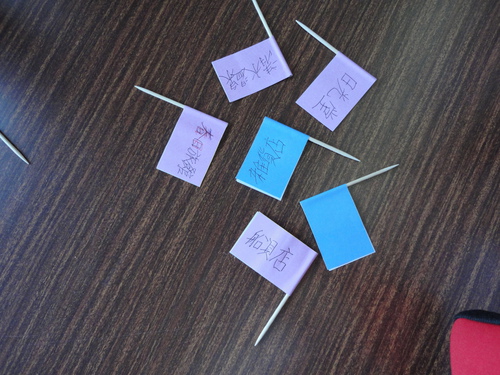
and sticking them in the island.
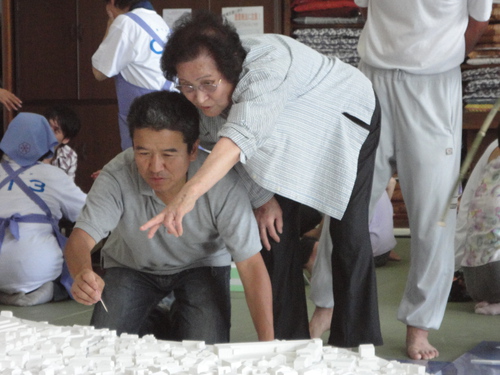
This model was then displayed at the art site, surrounded by blackboards on which further information was added as islanders shared new information.
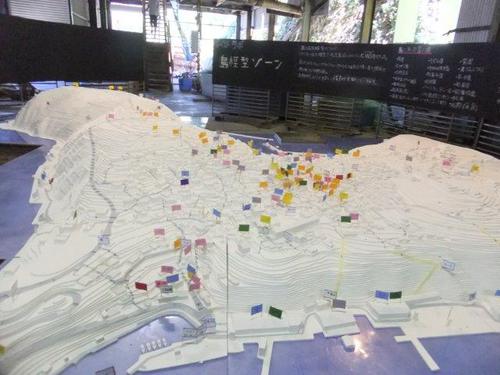
According to Sogabe, the collection of memories is just the preparatory stage. During this process, key people on the island are being identified and encouraged to keep the project moving. The team will continue to visit every 6 months or so as the islanders move on to the next phase of consulting on the island’s future and deciding what they want to save and what they want to let go.
The art site itself also utilized many mementos from the past to furnish the gallery and café.
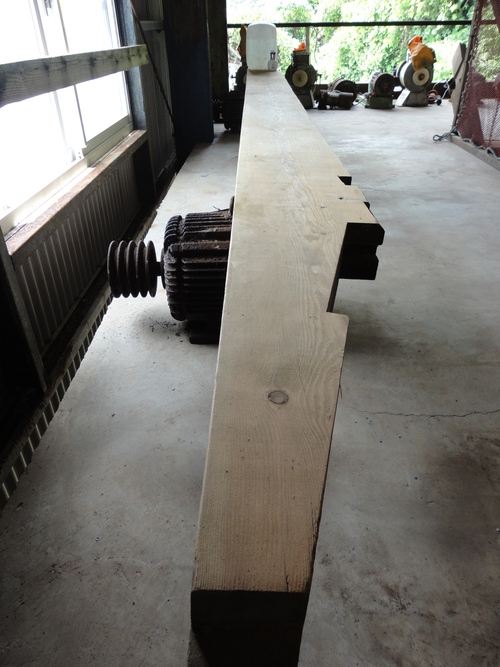

Other Triennale art sites included “Rainbow Hut” at the top of the island. I came across the artist, Tsuneo Sekiguchi, while his project was still in progress.

While making this work, Sekiguchi worked part time on the Ibukijima fishing boats to support himself but also to get to know the islanders. The hut is made of old blankets collected from the village and coated with adobe. Inside, pools of water with prisms catch the light and reflect it on the walls. Unfortunately, I missed seeing these but the very organic looking exterior was still worth the climb up the hill.


Further down the hill is “A Murmur of Small Island” by Taebeom Kim, set in the playground of a defunct nursery school. Kim
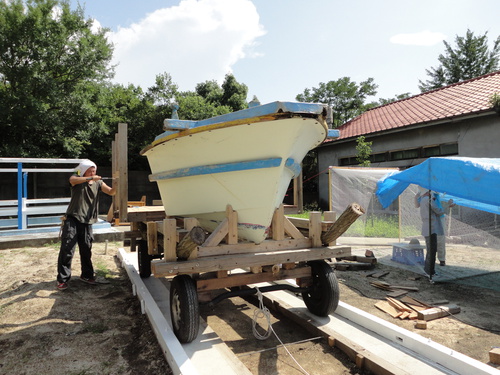
assisted by a team of volunteers,
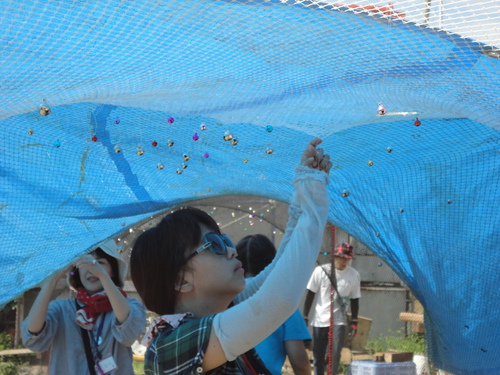
used an old boat and discarded playground equipment to create the fantasy land below.

“Unsinkable Ship” by Ryo Toyofuku & Chiba Art School presented another fantasyland, featuring 50,000 colorful floats made by islanders and Kanonji residents. These were strung through a school building to resemble schools of fish swimming through the sea.


There were more art sites but I am out of space. Let me conclude with “Oiwa Island 2” by Oscar Oiwa. For those who loved Oiwa Island on Ogijima, which burned down in 2010, this work certainly does not disappoint. This time Oscar used his marker magic to create a Setouchi panorama within a huge inflatable dome.
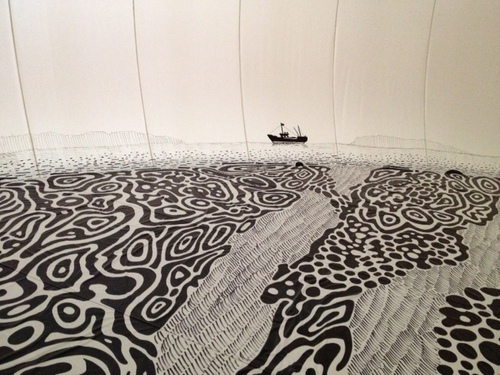
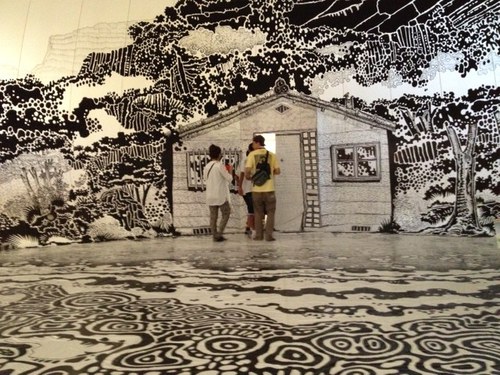
But Oscar really "says" it all and much better in this video of the project in the making:
http://www.youtube.com/watch?v=v99e3Wvp4qE
Although the Triennale on Ibukijima has ended, there is still the Triennale autumn session (Oct. 5 to Nov. 4) with 3 additional islands to look forward to. And, of course, the art sites on many islands will remain open even during the off-season (regular admission fees required). For more info, see: http://setouchi-artfest.jp/
Takamatsu Access:
Takamatsu makes a great base for visiting the Triennale. There are direct flights from Tokyo’s Haneda Airport, as well as from Taiwan, China and Korea, and an express bus link from Kansai International Airport (3 hr). It can also be reached by taking the bullet train to Okayama and changing to the Marine Liner bound for Takamatsu (runs every 1/2 hour; takes 1 hour). For more info see http://wikitravel.org/en/Takamatsu
Many thanks to K. Iwabuchi for helping with this article.

View from Mikan/Sogabe Lab site
This team of architects and students, led by Masashi Sogabe, has been involved in various experimental architectural projects for the reconstruction of communities devastated by the 2011 tsunami in northeastern Japan. They are applying this experience to the project on Ibukijima, a community that is being rapidly eroded by depopulation and aging. The project is temporarily housed in the unused fish processing plant in the photo below.

The team’s first step was to walk the entire island and then reproduce it as a model.

Every household was visited and invited to take part in the next step, the collection of memories. At the workshop, islanders shared memories of places that have disappeared,

writing the names of these places on flags

and sticking them in the island.

This model was then displayed at the art site, surrounded by blackboards on which further information was added as islanders shared new information.

According to Sogabe, the collection of memories is just the preparatory stage. During this process, key people on the island are being identified and encouraged to keep the project moving. The team will continue to visit every 6 months or so as the islanders move on to the next phase of consulting on the island’s future and deciding what they want to save and what they want to let go.
The art site itself also utilized many mementos from the past to furnish the gallery and café.


Other Triennale art sites included “Rainbow Hut” at the top of the island. I came across the artist, Tsuneo Sekiguchi, while his project was still in progress.

While making this work, Sekiguchi worked part time on the Ibukijima fishing boats to support himself but also to get to know the islanders. The hut is made of old blankets collected from the village and coated with adobe. Inside, pools of water with prisms catch the light and reflect it on the walls. Unfortunately, I missed seeing these but the very organic looking exterior was still worth the climb up the hill.


Further down the hill is “A Murmur of Small Island” by Taebeom Kim, set in the playground of a defunct nursery school. Kim

assisted by a team of volunteers,

used an old boat and discarded playground equipment to create the fantasy land below.

“Unsinkable Ship” by Ryo Toyofuku & Chiba Art School presented another fantasyland, featuring 50,000 colorful floats made by islanders and Kanonji residents. These were strung through a school building to resemble schools of fish swimming through the sea.


There were more art sites but I am out of space. Let me conclude with “Oiwa Island 2” by Oscar Oiwa. For those who loved Oiwa Island on Ogijima, which burned down in 2010, this work certainly does not disappoint. This time Oscar used his marker magic to create a Setouchi panorama within a huge inflatable dome.


But Oscar really "says" it all and much better in this video of the project in the making:
http://www.youtube.com/watch?v=v99e3Wvp4qE
Although the Triennale on Ibukijima has ended, there is still the Triennale autumn session (Oct. 5 to Nov. 4) with 3 additional islands to look forward to. And, of course, the art sites on many islands will remain open even during the off-season (regular admission fees required). For more info, see: http://setouchi-artfest.jp/
Takamatsu Access:
Takamatsu makes a great base for visiting the Triennale. There are direct flights from Tokyo’s Haneda Airport, as well as from Taiwan, China and Korea, and an express bus link from Kansai International Airport (3 hr). It can also be reached by taking the bullet train to Okayama and changing to the Marine Liner bound for Takamatsu (runs every 1/2 hour; takes 1 hour). For more info see http://wikitravel.org/en/Takamatsu
Many thanks to K. Iwabuchi for helping with this article.
Posted by cathy at
21:40
│Comments(2)
2013年08月31日
Ibukijima
The Setouchi Triennale summer session ends tomorrow and with it ends the Triennale on Ibukijima, an island about 2 hours travel from Takamatsu. It was the only island that elected to join the Triennale for the summer session alone, and the islanders chose to do so because that is fishing season.

Flotilla of fishing boats ready and waiting
They wanted visitors to see their home when the traditional industry, iriko (anchovy) fishing and processing, was at its peak. Brave souls, these islanders, because the Triennale meant an inundation of visitors and double the work at their busiest, and hottest!, time.

Here I share here a few impressions of Ibukijima.
The first thing that struck me on reaching the island was the number of motor scooters lined up at the port,
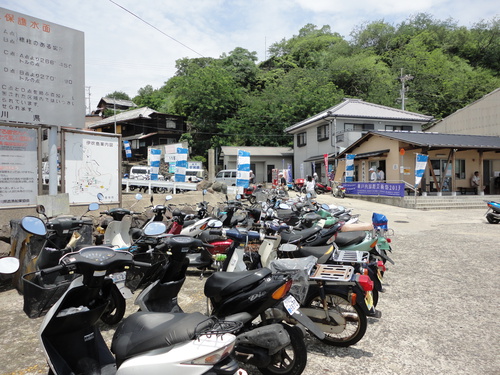
and the second was the fact that many still had the keys stuck in the ignition (obviously there is no escape for scooter thieves from Ibukijima).

Posters around town urged islanders to wear their helmets during the festival, which suggests that this is not a common practice on the island.
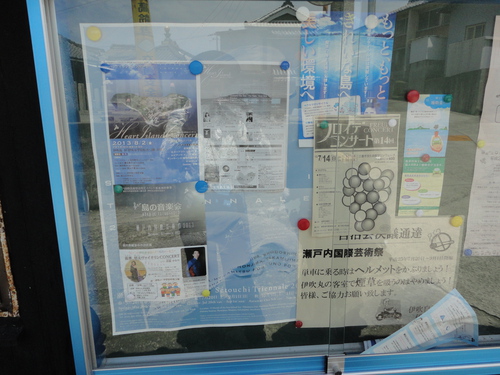
Ibukijima rises steeply out of the sea to form a flat tableland above. The hill that leads through the village is known as shinzo-yaburi or “heart rending hill”, and that is not a metaphor!

It’s not only steep but also very long, so I opted to veer left instead, taking a slightly gentler winding route and then cutting through the village in the middle. The village is a lovely, picturesque community, with many narrow, crisscrossing lanes

lined by lovely individualistic walls.

walls

and more walls

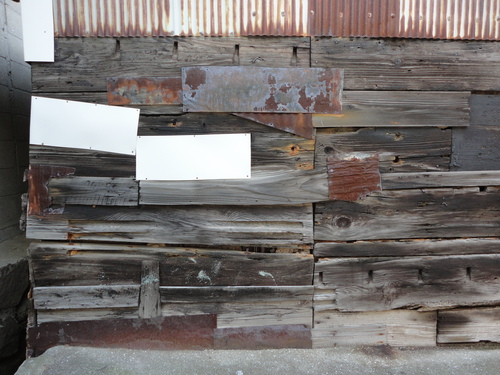
A number of walls demonstrated the reason islanders opt for the ubiquitous scooters rather than cars or trucks.
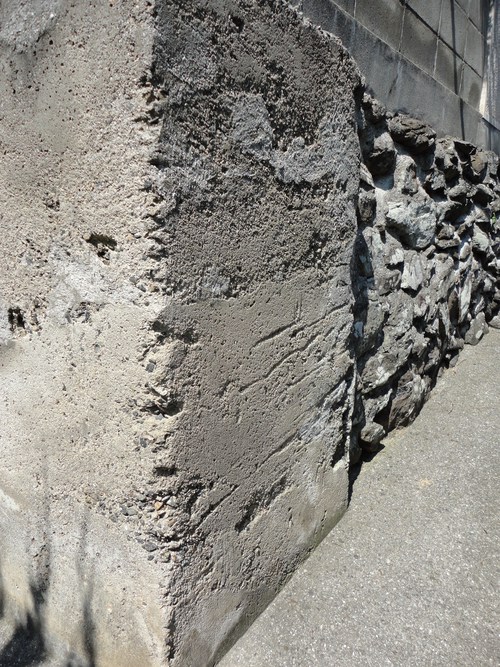
The sign on this wall announces: “Caution! This wall is moving. Be careful not to hit it with your car. If you do, you’ll pay for it.” It looks like quite a few people may have already paid for it.
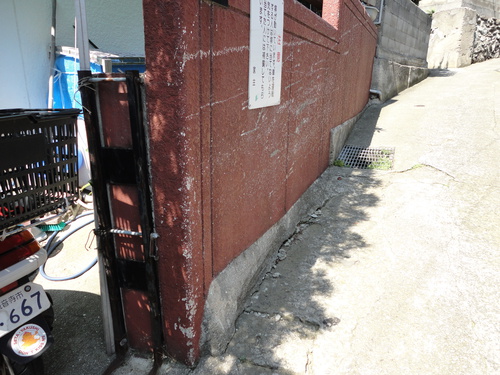
Besides being scenic, Ibukijima is also a very friendly island. Many people stopped to see if I needed help to get around the village or just to chat. One was this graphic designer and island native who currently lives in Okayama.

He is kindly displaying his pilgrim jacket. He had just climbed Mt. Ichizuchi (1,932 meters) in Ehime the day before, and had returned to Ibukijima to pray at Ichizuchi’s sister shrine on the island.
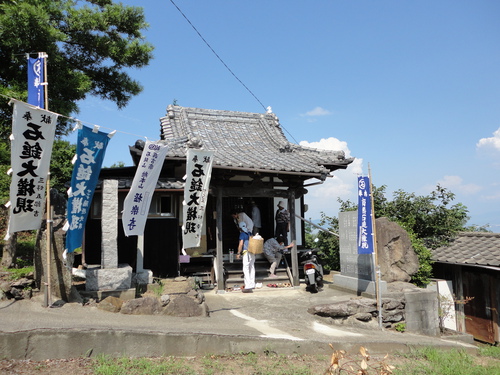
Although it would have helped if this weren’t the hottest summer on record, all of the above coupled with the incredible views from the island, made Ibukijima a great setting for the Setouchi Triennale art sites. (But I will introduce those in my next post.)

Takamatsu Access:
Takamatsu makes a great base for visiting the Triennale. There are direct flights from Tokyo’s Haneda Airport, as well as from Taiwan, China and Korea, and an express bus link from Kansai International Airport (3 hr). It can also be reached by taking the bullet train to Okayama and changing to the Marine Liner bound for Takamatsu (runs every 1/2 hour; takes 1 hour). For more info see http://wikitravel.org/en/Takamatsu
Posted by cathy at
21:16
│Comments(0)
2013年08月14日
Setouchi Triennale-Style Farmers’ Market
If you have been to the Setouchi Triennale or got on a ferry for any other reason, you may have noticed food stalls near the Meon ferry port in the early morning and late afternoon to evening.

These booths are run by local food growers and restaurants serving dishes made with local ingredients.

Apricot-sauce and rare sugar are both Kagawa specialty products
The market has actually been around for several years. Known as the Sanuki Marche, it is usually held every Sunday at Sunport and the emphasis is on homegrown organic produce, locally made products and gourmet cuisine. The weekly market is a chance for local businesses to get more exposure and meet more people.
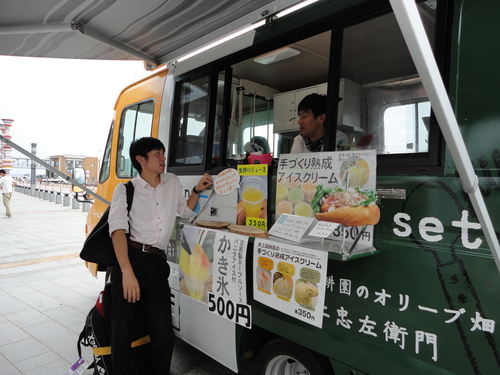
This year, it has teamed up with the Triennale to offer travelers great food every day as they get on and off the boat.
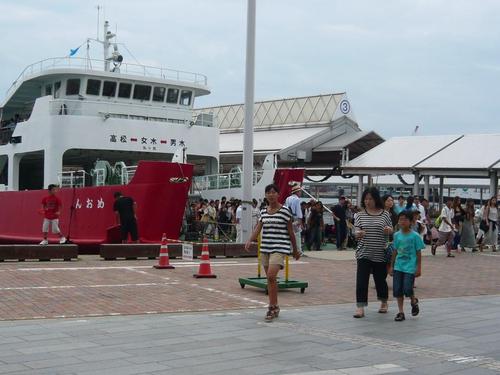
The Meon discharging its passengers
Marche, as far as I can tell, is a fancy word for Farmers’ Market. The people who show up and what they sell remind me of the great things to be found at Farmers’ Markets in Canada. It’s not only the food that’s fun but also the people involved. Each one has such an interesting story. This young gentleman, for example, used to live in Shizuoka.
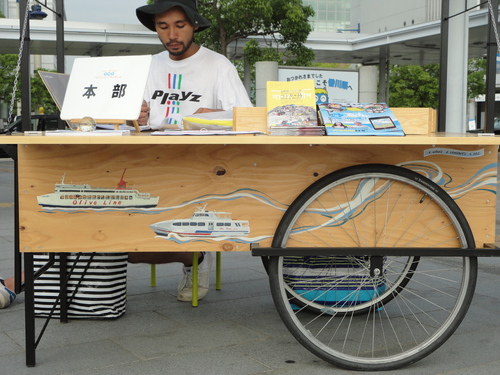
He came to Shikoku on the 88-temple pilgrimage route and decided to stay just because he liked it. (Sorry. I was actually taking a shot of the cart design – by Onba Factory.)
This woman was a baker but developed a severe wheat allergy.
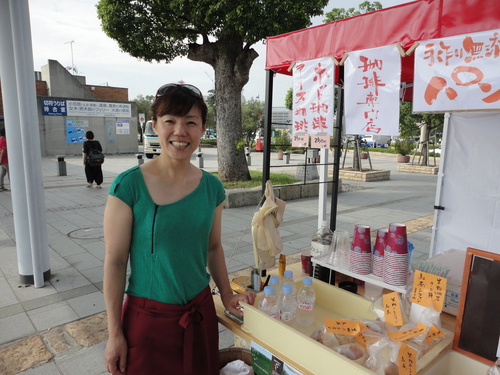
She changed her diet drastically and now runs a health food restaurant that helps people with allergies learn how to cook good food that they can eat safely. She bakes with rice flour while her mother continues making wheat bread.

Then there was the strawberry farmer
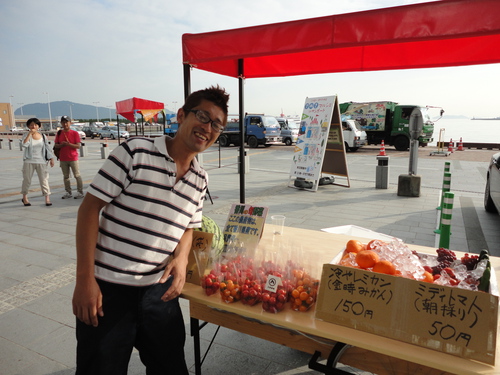
who was selling tomatoes, cucumbers, oranges and grapes for other farmers because strawberries are not in season.

And the friendly man from the local government who was helping out at 7:00 AM before going off to work at 8:30. (And he looked like he was enjoying it, too!)
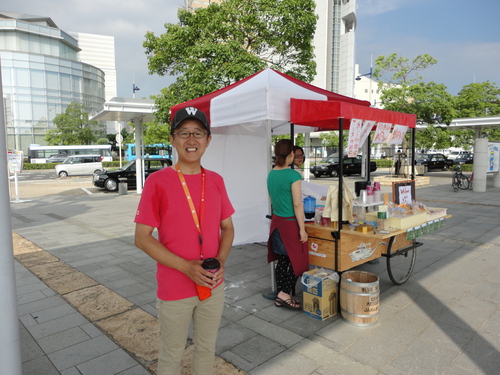
Here is my breakfast bought at the Marche. It was excellent.

On weekends in particular there’s entertainment offered too.

Street performer
And the Marche booths are located not only at the port but also at Bengal Island, just across the street.
Although not part of the Marche, the wares made by the Bengali artisans are often on sale now in the little shop where you can buy tickets for henna tattoos. This shop is open from 11:00 AM to 7:00 PM.

Please note that the paintings you see on the walls are not for sale but some of them will be auctioned on the last day of the Triennale's summer session (Sept. 1).
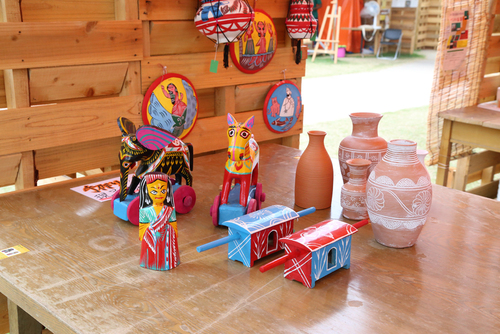

So, there’s lots to see and do this summer down at Takamatsu Port!
Until September 1, the last day of the Triennale, the port Marche is open daily from 7:00 AM to 10:00 AM for the island going crowd and again from 3:00 PM to 7:00 PM for those returning. The Bengal Island Marche is only open for the afternoon shift and I recommend going after 16:30 or later to avoid the heat.
For more info on the Triennale, see http://setouchi-artfest.jp/en/
Takamatsu Access:
Takamatsu can be reached by direct flights from Tokyo’s Haneda Airport, by express bus from Kansai International Airport (3 hr), and by direct flights from China and Korea. It can also be reached by taking the bullet train to Okayama and changing to the Marine Liner bound for Takamatsu (runs every 1/2 hour; takes 1 hour). For more info see http://wikitravel.org/en/Takamatsu
Posted by cathy at
03:10
│Comments(1)
2013年07月31日
Setouchi Triennale: Boats and Builders
Those of you who read my previous post know that the Setouchi Triennale has set up a Bengali marketplace at Takamatsu Port. Over the course of the summer session it will host about 100 Bengali artists, artisans and performers, as well as creative teams of Japanese and others holding demonstrations, events and workshops. In other words, great stuff!
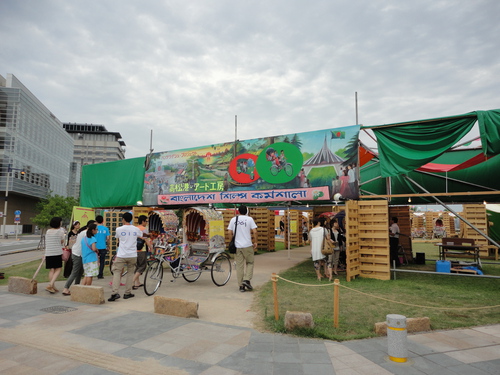
Bengal Island
Two boat building projects deserve special mention. The first is building a tenmasen or small cargo boat indigenous to the Setouchi region. The team consists of Douglas Brooks, Koji Matono and Takumi Suzuki.
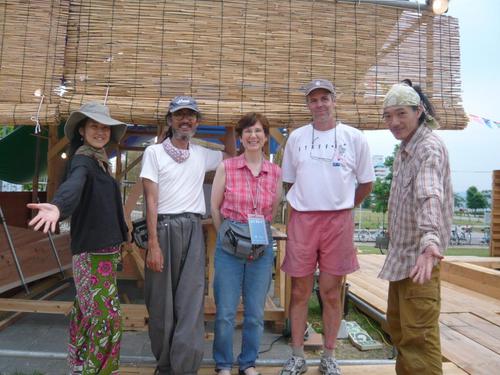
L to R: Mrs. Suzuki, Koji Matono, (me), Douglas Brooks, Takumi Suzuki
Matono, founder of the Wooden Boat Center in Takashima, builds all types of wooden boats (see http://woodenboat.jp/) while Suzuki builds canoes and serves as a river guide (www.hacarame.com).

Team at work
Douglas Brooks, an American, has been researching and documenting traditional Japanese boat building for 20 years. The techniques used, he told me, were carefully guarded secrets known only to the boat builders, who passed them on to their apprentices through on-the-job training. No detailed blueprints, no manuals, no records!
Realizing that with the death of each master boat builder, Japan and the world was losing priceless knowledge, Douglas began seeking out the masters and learning how to build boats typical of different regions before it was too late. Interesting that it often takes an “outsider” to recognize the value of something that is being lost!

Rice, fish and sake offerings for the boat's safety
To see the boat evolve through August, check out their blogs (http://blog.douglasbrooksboatbuilding.com/ http://woodenboat.jp/setouchi/). Better yet, come down to the port and see the team in action. Admission is free so if you’re in the area, drop by as often as you like.
The second project is by a team of Bangladeshis building a small traditional craft.
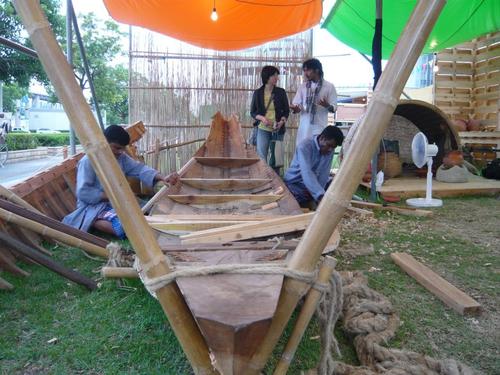
Bengali boat
Like Japan, Bengali shipwrights passed down their skills orally and, consequently, Bangladesh is also on the verge of losing its rich boat building heritage.

Wasama Doja, the manager of Contic, a company that transforms traditional riverboats into luxury cruisers, is an eloquent spokesperson for this endangered technology and the beautiful craft they produce (See http://www.contic.net/ ).
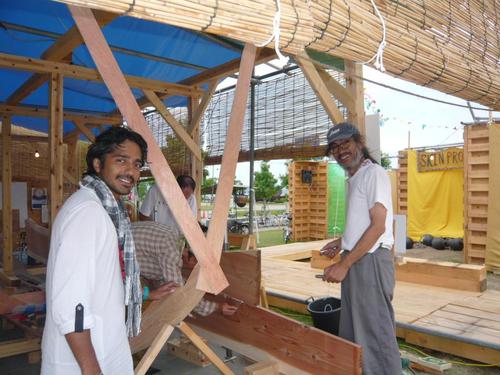
Wasama Doja drops in on the tenmasen team
The techniques used in building the boat on Bengal Island, he tells me, date back 3,000 years and the ingenious metal staples that secure the planks together represented a major evolution in boat building.
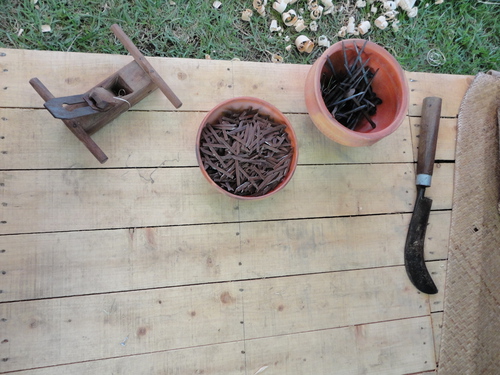
Tools, staples and nails are all handmade.

Contic, Wasama explained, actually became involved in preserving traditional skills when they discovered that no one remembered how to weave the sails for a beautiful old ship they were converting. Since then, they have taken many steps to keep this knowledge alive, such as making models that are perfect replicas, 3D blueprints, of different types of boats.
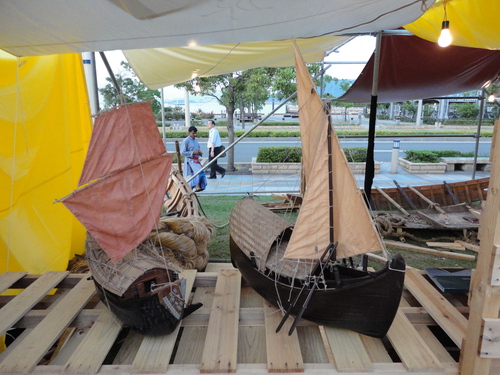
Replicas
There is a great rapport between these two teams. The builders visit each other’s site to appreciate and exchange knowledge and skills—a perfect example of what the Setouchi Triennale and Bengal Island are all about. If you haven’t been yet, please do go. If you have been, go again and get to know some of the amazing people and their crafts.
For more information on the Setouchi Triennale, see http://setouchi-artfest.jp/en/
Takamatsu Access:
Takamatsu can be reached by direct flights from Tokyo’s Haneda Airport, by express bus from Kansai International Airport (3 hr), and by direct flights from China and Korea. It can also be reached by taking the bullet train to Okayama and changing to the Marine Liner bound for Takamatsu (runs every 1/2 hour; takes 1 hour). For more info see http://wikitravel.org/en/Takamatsu

Bengal Island
Two boat building projects deserve special mention. The first is building a tenmasen or small cargo boat indigenous to the Setouchi region. The team consists of Douglas Brooks, Koji Matono and Takumi Suzuki.

L to R: Mrs. Suzuki, Koji Matono, (me), Douglas Brooks, Takumi Suzuki
Matono, founder of the Wooden Boat Center in Takashima, builds all types of wooden boats (see http://woodenboat.jp/) while Suzuki builds canoes and serves as a river guide (www.hacarame.com).

Team at work
Douglas Brooks, an American, has been researching and documenting traditional Japanese boat building for 20 years. The techniques used, he told me, were carefully guarded secrets known only to the boat builders, who passed them on to their apprentices through on-the-job training. No detailed blueprints, no manuals, no records!
Realizing that with the death of each master boat builder, Japan and the world was losing priceless knowledge, Douglas began seeking out the masters and learning how to build boats typical of different regions before it was too late. Interesting that it often takes an “outsider” to recognize the value of something that is being lost!

Rice, fish and sake offerings for the boat's safety
To see the boat evolve through August, check out their blogs (http://blog.douglasbrooksboatbuilding.com/ http://woodenboat.jp/setouchi/). Better yet, come down to the port and see the team in action. Admission is free so if you’re in the area, drop by as often as you like.
The second project is by a team of Bangladeshis building a small traditional craft.

Bengali boat
Like Japan, Bengali shipwrights passed down their skills orally and, consequently, Bangladesh is also on the verge of losing its rich boat building heritage.

Wasama Doja, the manager of Contic, a company that transforms traditional riverboats into luxury cruisers, is an eloquent spokesperson for this endangered technology and the beautiful craft they produce (See http://www.contic.net/ ).

Wasama Doja drops in on the tenmasen team
The techniques used in building the boat on Bengal Island, he tells me, date back 3,000 years and the ingenious metal staples that secure the planks together represented a major evolution in boat building.

Tools, staples and nails are all handmade.

Contic, Wasama explained, actually became involved in preserving traditional skills when they discovered that no one remembered how to weave the sails for a beautiful old ship they were converting. Since then, they have taken many steps to keep this knowledge alive, such as making models that are perfect replicas, 3D blueprints, of different types of boats.

Replicas
There is a great rapport between these two teams. The builders visit each other’s site to appreciate and exchange knowledge and skills—a perfect example of what the Setouchi Triennale and Bengal Island are all about. If you haven’t been yet, please do go. If you have been, go again and get to know some of the amazing people and their crafts.
For more information on the Setouchi Triennale, see http://setouchi-artfest.jp/en/
Takamatsu Access:
Takamatsu can be reached by direct flights from Tokyo’s Haneda Airport, by express bus from Kansai International Airport (3 hr), and by direct flights from China and Korea. It can also be reached by taking the bullet train to Okayama and changing to the Marine Liner bound for Takamatsu (runs every 1/2 hour; takes 1 hour). For more info see http://wikitravel.org/en/Takamatsu
Posted by cathy at
00:23
│Comments(4)
2013年07月30日
Triennale: Art in Daily Life
Bengal Island is a fascinating highlight of the Setouchi Triennale 2013. Running for the entire summer session (July 20 to September 1), it features artists, artisans and performers from Bangladesh in large numbers (about 100 in fact!).
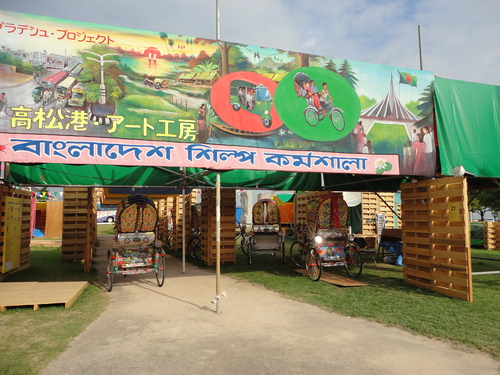
But what do masters of traditional Bengali arts and crafts have to do with the Triennale, a contemporary art festival held on 12 islands in the Seto Inland Sea?
Intrigued, I made my way through the numerous craft factories, watching the occupants at work and stopping to chat. The answer to my question was obvious. This is where art begins – in daily life, in making the tools, implements, clothing, furniture, and all the “ordinary” things we use. The whole site is a celebration of the joy humans take in creation, of our quest for beauty within utility.
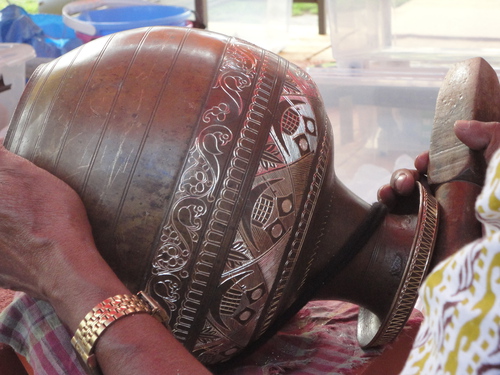
Rather than the “works”, it is the workmanship that is on display, and it is amazing to watch. The government of Bangladesh supplied people who are top in a wide array of fields, including metal working and pottery,

embroidery and weaving,

henna tattoing and toy making,

bus, car and rickshaw painting.


The artisans are able to do so much with so little. Take this rudimentary wooden pottery wheel, for instance.
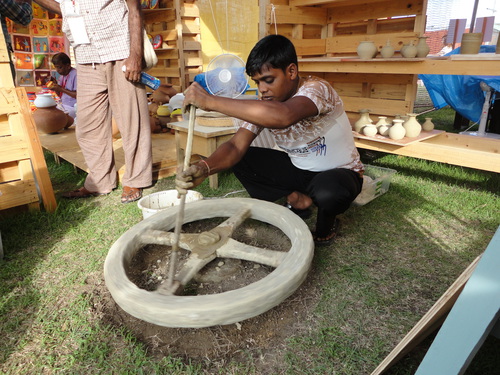


Nor do the workers need benches and clamps to secure their work. Feet and rope do the job!


These women produce stunning textiles, using their bodies to anchor the loom.


Quite a few artisans speak some English and are very willing to share their passion for their work so give yourself enough time to stop and chat, or just watch what they do. There are also participatory projects by Japanese artists, including Takashi Nishibori and a team of Thai university students, who are creating a constantly growing work of latticed bamboo,
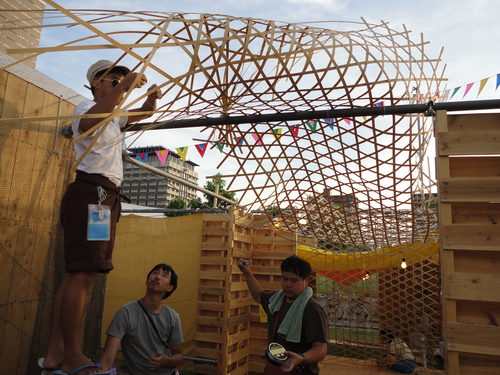
students and teachers from the MEGI HOUSE project on Megijima, who are making not-so-musical instruments from tubes and everyday objects,

and umi-tama, who is making dolls out of eggshells and Japanese paper (JPY300 to make one; results will be exhibited in October in Shikokumura).

There are also daily open-air performances of Bengali dance, music and songs, by topnotch performers.

Admission is FREE, for everyone. No Triennale Passport required. Bengal Island is open daily from 3:30PM to 7:30 PM, but because of the heat, most of the action happens after 4:30PM. There are performances from 5:30 and 6:30 daily except in bad weather, workshops at different booths, and food and refreshments to be bought. Whether you are going to the Triennale or not, drop in and see what’s happening.
Location: On the west side of the Shodoshima/Naoshima ferry terminal at Takamatsu Port and north of the Takamatsu Port Setouchi Parking area.
Takamatsu Access:
Takamatsu can be reached by direct flights from Tokyo’s Haneda Airport, by express bus from Kansai International Airport (3 hr), and by direct flights from China and Korea. It can also be reached by taking the bullet train to Okayama and changing to the Marine Liner bound for Takamatsu (runs every 1/2 hour; takes 1 hour). For more info see http://wikitravel.org/en/Takamatsu
Posted by cathy at
00:49
│Comments(0)
2013年07月10日
Lotus Pond
What’s a nice way to beat the heat in Takamatsu? Taking a stroll in one of the most beautiful spots in Japan—Ritsurin Garden. The largest traditional garden of its kind in Japan, it was awarded 3 stars in the Michelin Green Guide.

Established almost 4 hundred years ago as a villa for the ruling lord and his family, Ritsurin took almost a century to complete and is now maintained by a team of topnotch gardeners and volunteers.

Gardeners
One of my favorite features is the fact that Ritsurin Garden is open from sunrise to sunset. In July, that means it opens from about 5:30 AM when it is still pleasantly cool.
In summer, early morning is also the perfect time to enjoy the lotus blossoms in Fuyo-ho (Lotus Pond).
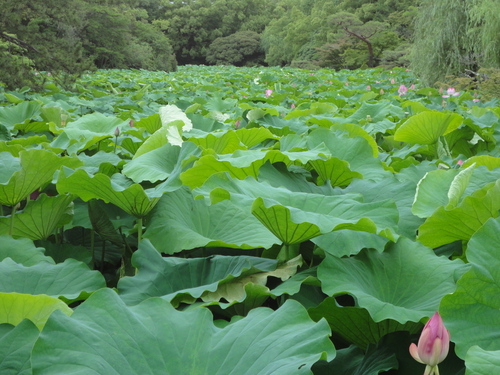
Enormous umbrella-like leaves cover the 5,500 m2 pond from one end to the other. These carp seemed to be enjoying the leafy jungle, too.

With plenty of good photo-ops, there are often photographers in the garden from first light. I, as you may know by now, am not a great photographer, so I picked a cloudy day and went later. The blossoms were still beautiful even after lunch, making me wish that I was a good photographer!

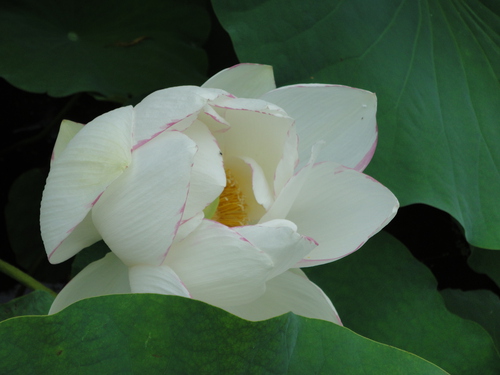
I definitely recommend taking a break in one of the teahouses. After all, this garden was created to be viewed from inside as well as from outside. Here are some of the views from Kikugetsu-tei, the largest teahouse and the only one open on both weekdays and holidays.


If it rains, the staff will rush to close the shutters. The mechanics are pretty special, so don’t be sad if this happens while you are there. The staff will quite happily show you how the shutters, which are all stored at one end of the building, are swung out and around the corner posts and pushed round to cover the entire façade.

So for those of you who are staying in Takamatsu, even for a short time, definitely take the time to drop in to Ritsurin Garden. If you can, plan to spend at least an hour if not more. It’s well worth it.
Admission: JPY400 (JPY170 for children)
Kikugetsu-tei: Entrance fee comes with tea and a sweet. JPY510 for green tea, JPY710 for powdered green tea. Or get a discount by buying a combined garden entrance/tea ticket when you enter.
More info: http://www.pref.kagawa.lg.jp/ritsurin/index_e.html
Takamatsu Access:
Takamatsu can be reached by direct flights from Tokyo’s Haneda Airport, by express bus from Kansai International Airport (3 hr), and by direct flights from China and Korea. It can also be reached by taking the bullet train to Okayama and changing to the Marine Liner bound for Takamatsu (runs every 1/2 hour; takes 1 hour). For more info see http://wikitravel.org/en/Takamatsu
2013年07月01日
End of an Era
The other day I was offered a glimpse of Takamatsu’s past through the lens of what was once an enormous mansion named Urushihara Manor. Built about 150 years ago, the site is as big as a school with the grounds included. If you can read the plan drawing below, you will notice a shrine up in the north corner and a bridge at the bottom to cross the moat, and I mean moat not just a ditch.

Why was this home built like a fortress, with protection from the gods to boot? Because the owner was the village official who stored all the grain collected as tax before sending it on to the lord. That was a hefty responsibility. Beyond the moat, thick walls surrounded the site to deter thieves
and the entrance was flanked by long gatehouses that sheltered workers and servants, as well as various tools and equipment.
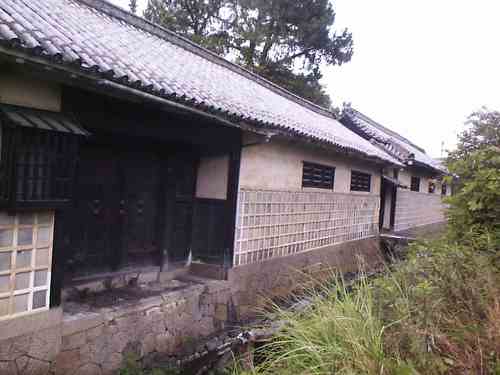
The namako ridged plaster on the walls and the seamless fitting of the stone foundations are testimony to the wealth of its owner.
Landlords dominated Japan’s rural society and politics until the end of World War II. Elderly neighbors have told me that all the land around our home once belonged to a single landlord. The fields were worked by tenants and they, as children, were very aware that they were walking across the landlord’s fields when they went to school.
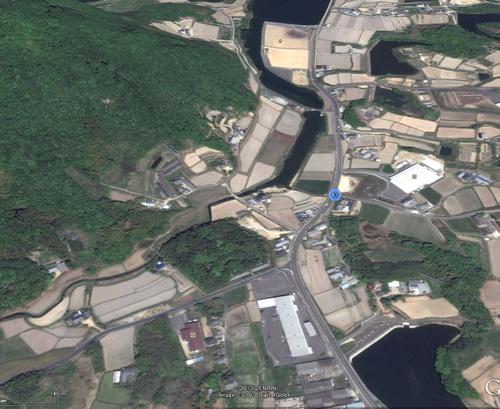
Aerial view (Urushihara Manor is the green square left of center)
All that changed under the American Occupation and the push towards democratization. Drastic land reform demolished the class structure by redistributing farmland to commoners. This was bad news for Urushihara Manor. Suddenly the owner found himself with an immense residence but not enough farmland to generate the income needed for its upkeep. The result was rapid decline, and the building was abandoned within 20 years. After it was abandoned, Shuji Terayama used the premises for filming “Grass Labyrinth”, and others tried to find ways to preserve it, but in the end, it simply cost too much to maintain.

Now, the jungle has taken over and the buildings within have all but disintegrated into the forest, testimony to the end of an era.

Takamatsu Access:
Takamatsu can be reached by direct flights from Tokyo’s Haneda Airport, by express bus from Kansai International Airport (3 hr), and by direct flights from China and Korea. It can also be reached by taking the bullet train to Okayama and changing to the Marine Liner bound for Takamatsu (runs every 1/2 hour; takes 1 hour). For more info see http://wikitravel.org/en/Takamatsu
Posted by cathy at
01:46
│Comments(0)
2013年07月01日
A Secret Garden
Takamatsu and Kagawa prefecture seem to have been blessed for centuries with wealthy patrons of the arts, including the art of gardening. Visit the exquisite Ritsurin Garden in Takamatsu and you will know what I mean
(http://cathy.ashita-sanuki.jp/e229240.html ).
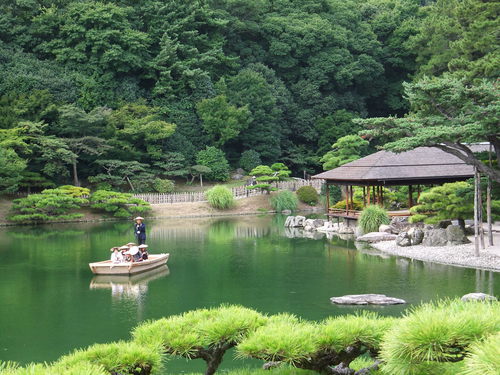
Ritsurin garden
Recently, I discovered another fascinating garden hidden away in the little town of Shido, just a short trip east of Takamatsu. Or actually, 2 gardens, one very ancient and another by a modern master of landscape and garden design named Mirei Shigemori (1896-1975). Both are located on the grounds of Shido Temple (86th on the Shikoku pilgrimage circuit and also worth a visit).
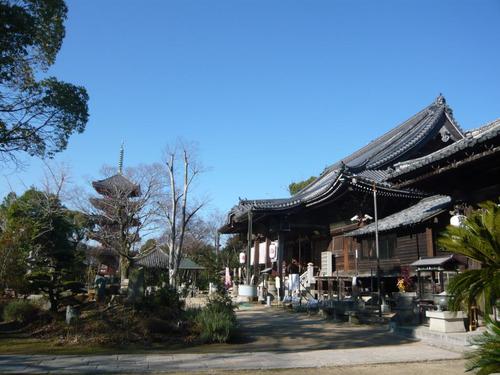
Shido temple
The first garden was created in the 15th century, which makes it 550 years old. That’s pretty impressive for a garden in a tiny rural town like this. Commissioned by the local ruler of that time, it was designed to evoke ink wash paintings of Chinese landscapes depicting a river flowing through mountains.

It is one of only 3 gardens of its kind, the others being located in Shiga and Mie. After it was badly damaged by an earthquake, however, it fell into disrepair and was neglected for many years.
4 Muromachi jidai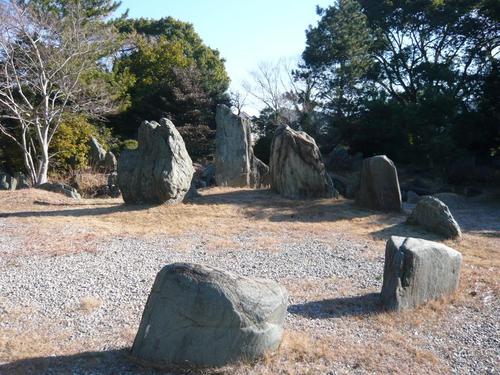
Check out the photos in this article to get an image of the garden in its entirety. http://muso.to/teienn-sidoji.htm
It was Mirei Shigemori who resurrected it. Shigemori extensively documented gardens of note around Japan and I am guessing that that was how he found this one. It is not easy to find even once inside the temple! Shigemori is famous for his recreation of the gardens of Tofuku-ji Temple in Kyoto, and also collaborated with Isamu Noguchi, the Japanese-American sculptor who had a studio on the east side of Takamatsu. In addition to resurrecting the ancient garden, Shigemori added one of his own in the karesansui or dry landscape style.
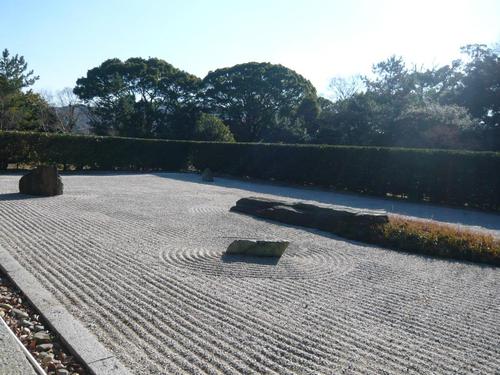
Like the zen garden in Ryoanji Temple in Kyoto, it is a deceptively simple arrangement of rocks and gravel intended to aid meditation.
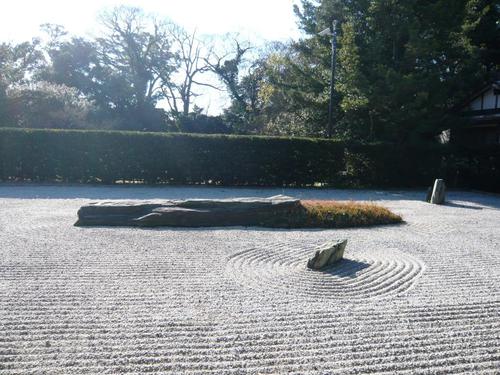
Founded in the 7th century, Shido Temple is famous for the legend of a prince’s loyal consort whose grave is located on the temple grounds. A diver, this woman sacrificed her life to retrieve a precious ball the prince had lost in the sea. Shigemori’s garden was made in memory of her, as was a sculpture by Isamu Noguchi, The Mermaid’s Grave.
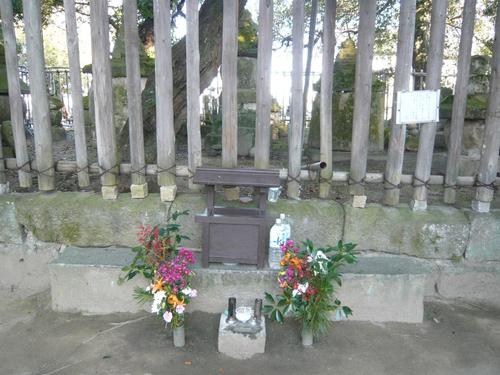
Grave at the temple.
Getting to Shido
From Takamatsu Stn, take the JR bound for Tokushima (25 min., JPY350). Get off at Shido. About 10 min. walk. You can also take the Kotoden line from Kawaramachi Stn in central Takamatsu to Shido.
Takamatsu Access:
Takamatsu can be reached by direct flights from Tokyo’s Haneda Airport, by express bus from Kansai International Airport (3 hr), and by direct flights from China and Korea. It can also be reached by taking the bullet train to Okayama and changing to the Marine Liner bound for Takamatsu (runs every 1/2 hour; takes 1 hour). For more info see http://wikitravel.org/en/Takamatsu
(http://cathy.ashita-sanuki.jp/e229240.html ).
Ritsurin garden
Recently, I discovered another fascinating garden hidden away in the little town of Shido, just a short trip east of Takamatsu. Or actually, 2 gardens, one very ancient and another by a modern master of landscape and garden design named Mirei Shigemori (1896-1975). Both are located on the grounds of Shido Temple (86th on the Shikoku pilgrimage circuit and also worth a visit).

Shido temple
The first garden was created in the 15th century, which makes it 550 years old. That’s pretty impressive for a garden in a tiny rural town like this. Commissioned by the local ruler of that time, it was designed to evoke ink wash paintings of Chinese landscapes depicting a river flowing through mountains.

It is one of only 3 gardens of its kind, the others being located in Shiga and Mie. After it was badly damaged by an earthquake, however, it fell into disrepair and was neglected for many years.
4 Muromachi jidai

Check out the photos in this article to get an image of the garden in its entirety. http://muso.to/teienn-sidoji.htm
It was Mirei Shigemori who resurrected it. Shigemori extensively documented gardens of note around Japan and I am guessing that that was how he found this one. It is not easy to find even once inside the temple! Shigemori is famous for his recreation of the gardens of Tofuku-ji Temple in Kyoto, and also collaborated with Isamu Noguchi, the Japanese-American sculptor who had a studio on the east side of Takamatsu. In addition to resurrecting the ancient garden, Shigemori added one of his own in the karesansui or dry landscape style.

Like the zen garden in Ryoanji Temple in Kyoto, it is a deceptively simple arrangement of rocks and gravel intended to aid meditation.

Founded in the 7th century, Shido Temple is famous for the legend of a prince’s loyal consort whose grave is located on the temple grounds. A diver, this woman sacrificed her life to retrieve a precious ball the prince had lost in the sea. Shigemori’s garden was made in memory of her, as was a sculpture by Isamu Noguchi, The Mermaid’s Grave.

Grave at the temple.
Getting to Shido
From Takamatsu Stn, take the JR bound for Tokushima (25 min., JPY350). Get off at Shido. About 10 min. walk. You can also take the Kotoden line from Kawaramachi Stn in central Takamatsu to Shido.
Takamatsu Access:
Takamatsu can be reached by direct flights from Tokyo’s Haneda Airport, by express bus from Kansai International Airport (3 hr), and by direct flights from China and Korea. It can also be reached by taking the bullet train to Okayama and changing to the Marine Liner bound for Takamatsu (runs every 1/2 hour; takes 1 hour). For more info see http://wikitravel.org/en/Takamatsu
Posted by cathy at
00:25
│Comments(0)
2013年06月01日
Shodoshima and the Triennale
Shodoshima has really gotten into the swing of things for Setouchi Triennale 2013 (http://setouchi-artfest.jp/en/). Whereas in 2010, only a few areas were involved, this time, every community seems to have joined in, connecting the festival with existing art in residency programs and local artists.
While Shodoshima is not in Takamatsu, it’s just 60 minutes away by ferry on a very scenic route (30 minutes by speed boat). The island is so large and the art sites are so widely spread that it is quite hard to see them all in one day even with your own car. I recommend either staying overnight or picking specific sites to see.
Due to space restraints, here is a sample of just 3 that I was fortunate to see still in the making. Very interesting stuff!
“Maze Town – Phantasmagoric Alleys:” The streets near the port of Tonosho town were intentionally laid out in a maze-like pattern to deter invading pirates, a fact that dovetails perfectly with this project.

Launched by a group of 4 young artists, the project envisions transforming the area into a maze over the next ten years. Abandoned buildings will be turned into individual mazes, while a labyrinth of walkways will join these buildings together. As this will require the support of the whole community, the team started by transforming a tobacco shop into a maze to help local residents understand the concept,.

Locals were asked to contribute materials as well as volunteer labor.

Poster soliciting materials.
Look what materials were used to insulate the walls – old futon!

Volunteers taking a break
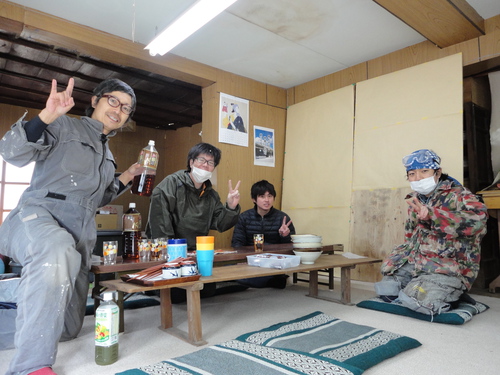
Another project I caught in the making was Kana Yoshida’s “The Secret of Hanasuwajima.” Kana was an artist in residence who fell in love with Shodoshima and became a resident. A diver, she took underwater photos of a little outcrop near her home on Shodoshima,
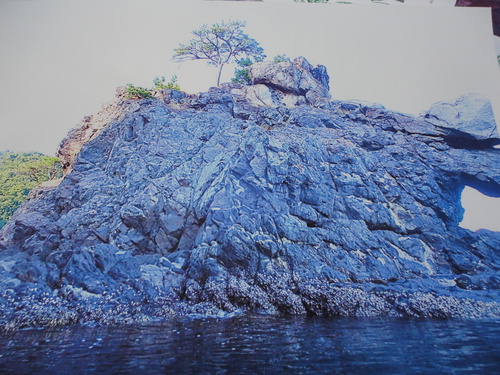
then painstakingly reproduced them in pastel on styrofoam and turned the island inside out so that the viewer can see it from every side and angle, as if standing underwater and looking up.

Kana explaining the concept

Work in progress
Finally, let me revisit Wang Wen Chih’s “The Light of Shodoshima”. Again, this project involved the cooperation of many volunteers and local people, especially in providing the thousands of bamboo needed to build the structure.

“The Light of Shodoshima” in the making

Bamboo grows like a weed and takes over healthy forests and fields rapidly if it is not kept in check, so the locals were very happy to find such a good use for it. This was Wang’s second time to build here, and he was wonderfully friendly and welcoming to all. He, his team and the many volunteers were kept well fed by Ota-san, a young local man who returned to Shodoshima just last year and is running Komame Shokudo, the restaurant at the top of the hill (very nice!).
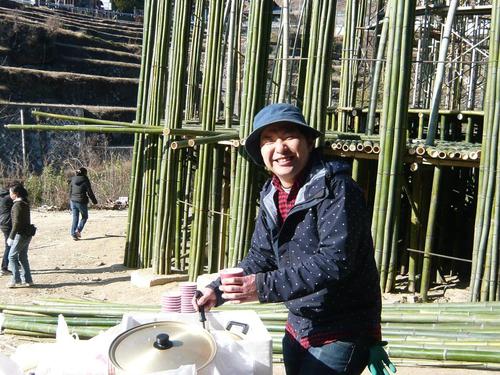
Ota-san serving sweet bean soup
Well, I’m definitely out of space so let me sign off with a few of my favorite views on Wang’s finished product and the reminder that there is much, much more to be experienced and enjoyed on Shodoshima and at the Setouchi Triennale 2013.

Takamatsu Access, etc.
http://wikitravel.org/en/Takamatsu
Many thanks to Hiroko.
Posted by cathy at
00:10
│Comments(0)





